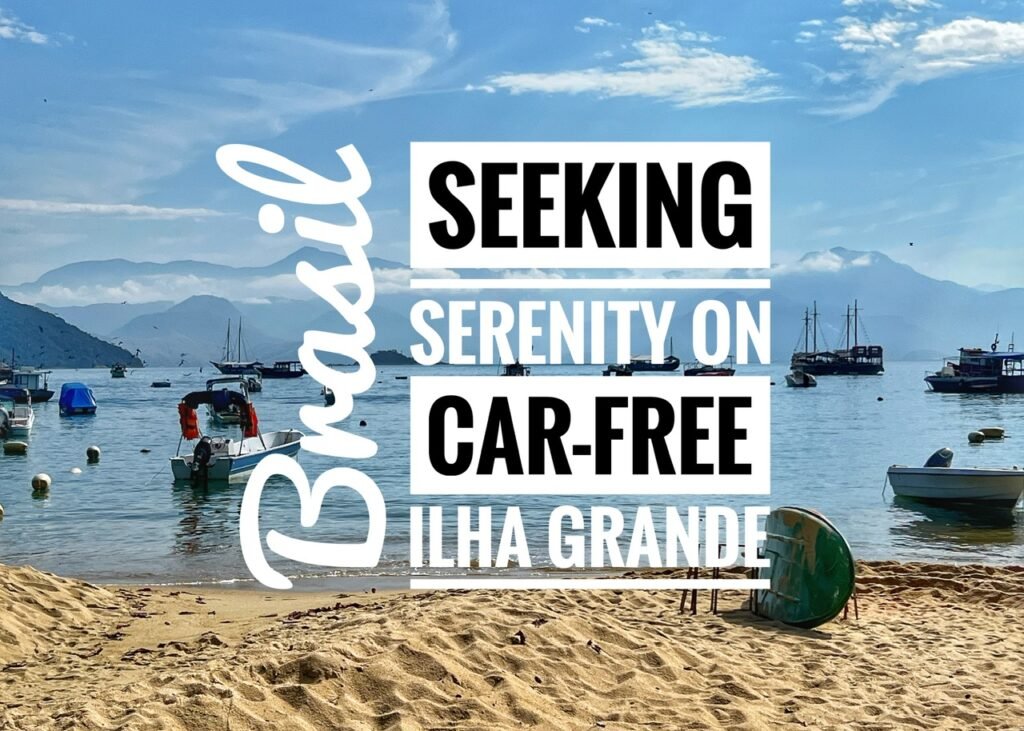
Getting There (Is Half the fun?!)

Flashing us back to India or Nepal, getting to Ilha Grande was the complete backpacker package to welcome us back to our fast travel month of August 2023. We don’t have days like this very often (anymore), so it’s always good to have a reminder of why we don’t. 🤣 It was complete with sweat-on-sweat sardine-stuffed public transportation, a stay in what seemed to be Brazil’s version of a trucker stop, and way too much white fluffy “bread,” it took us from Rio de Janiero to Mangaratiba, which is…surprise…the budget way to get to the alluring destination of Ilha Grande.
If you drove a car, it only takes two hours to get from Rio to Mangaratiba. We knew taking public transportation would take longer, but save a lot, so we were more than willing to deal with a few transfers. In the end, it took about five hours and cost about $8 for both of us, as opposed to ~$24.
Our plan was to take the yellow metro line to Jardin Oceanico (the end of the line) and then hop on the number 10 BRT (Brazil Regional Transport) accordion bus to the end of the line in Santa Cruz, followed by a local bus to Itaguai and another one to Mangaratiba.
We made the mistake of getting on the 22 bus at Jardin Oceanico and then transferring to the 10 instead of waiting there to board the 10 directly. Bus 10 seemed to be designed with stimulating levels of misery:
-Level Um: One of the four doors was not working (an annoyance, but whatever)
-Level Dois: It was standing room only for this 1.5 hour ride with our backpacks uncomfortably sandwiched ‘neath our feet. (Nothing new…we’ve dealt with this many times.)
-Level Tres: With each stop, we were slowly closed in on from all sides like pigs in a sty. Random hands, possibly attached to bodies, start criss-crossing in every direction around you to try and find something to grasp onto, which was an absolute necessity as the colossal caterpillar bus rolled from side to side like Thunder Mountain Railroad. Not to mention, the people that were literally dangling out the back door because there was no room for them to cram in and the door wouldn’t close. (Uh….Getting a tad uncomfortable.)
-Level Quatro: it wasn’t that hot to begin with but, with no AC and this many people, the sweat began rolling around body parts and creating a sweaty human stew. By this time, we needed some optimism so, our next thought was…well, at least there’s no…)
-Level Cinco: Traffic. Shit. Stalling for a good 30 minutes, bare skin to bare skin compressed with your neighbor’s arm, butt or foot, with no airflow and little movement. In order to avoid panicking, it was time for Mandy to employ deep breathing and gratitude exercises…indeed, deep gratitude that this commute isn’t part of our daily existence. Seriously! These poor people!
By the time we got to Santa Cruz, needless to say we were thrilled to find a seat in a fabulous VW van, called a combi here, to transport us to Itaguai, followed by a giant uncrowded chariot of a local bus to Mangaratiba.
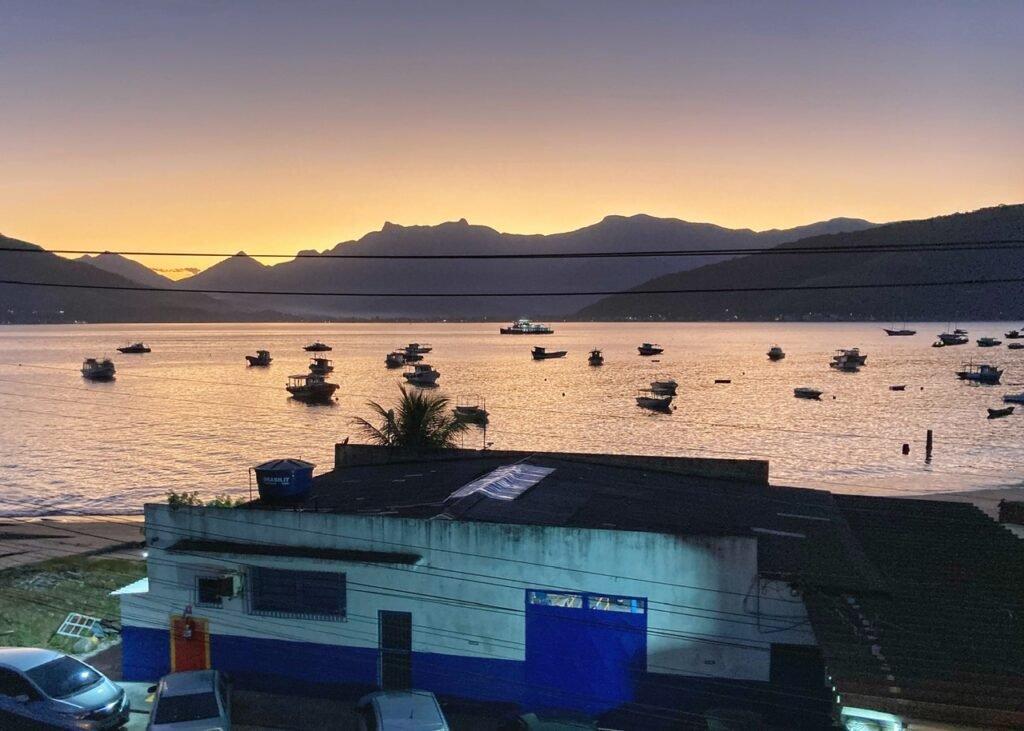
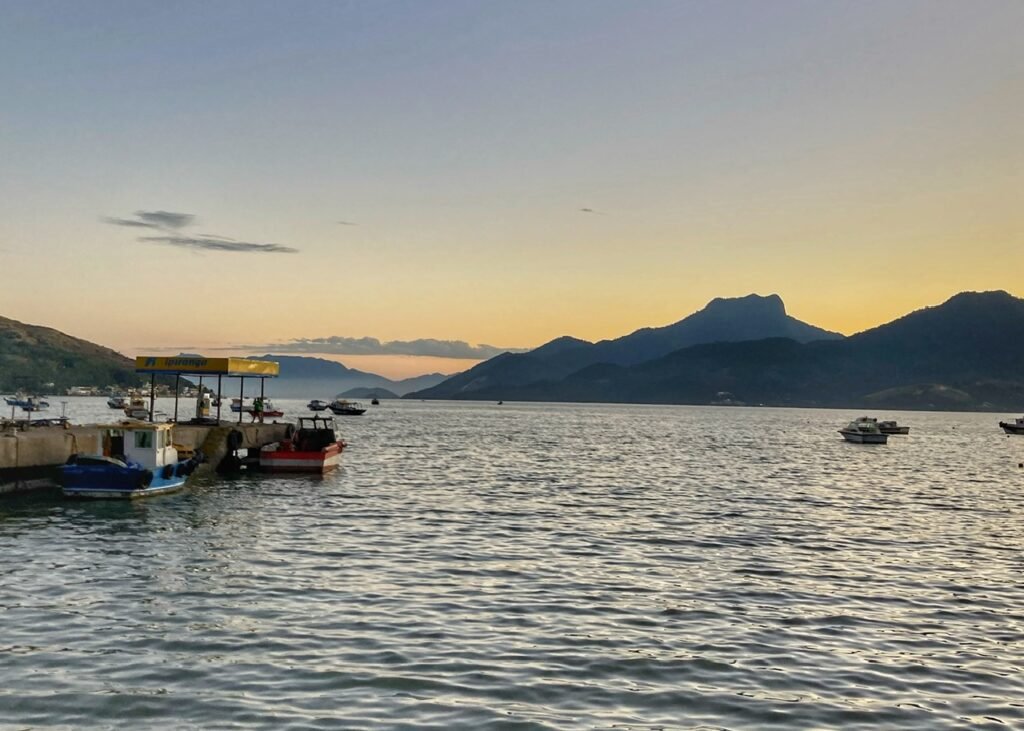
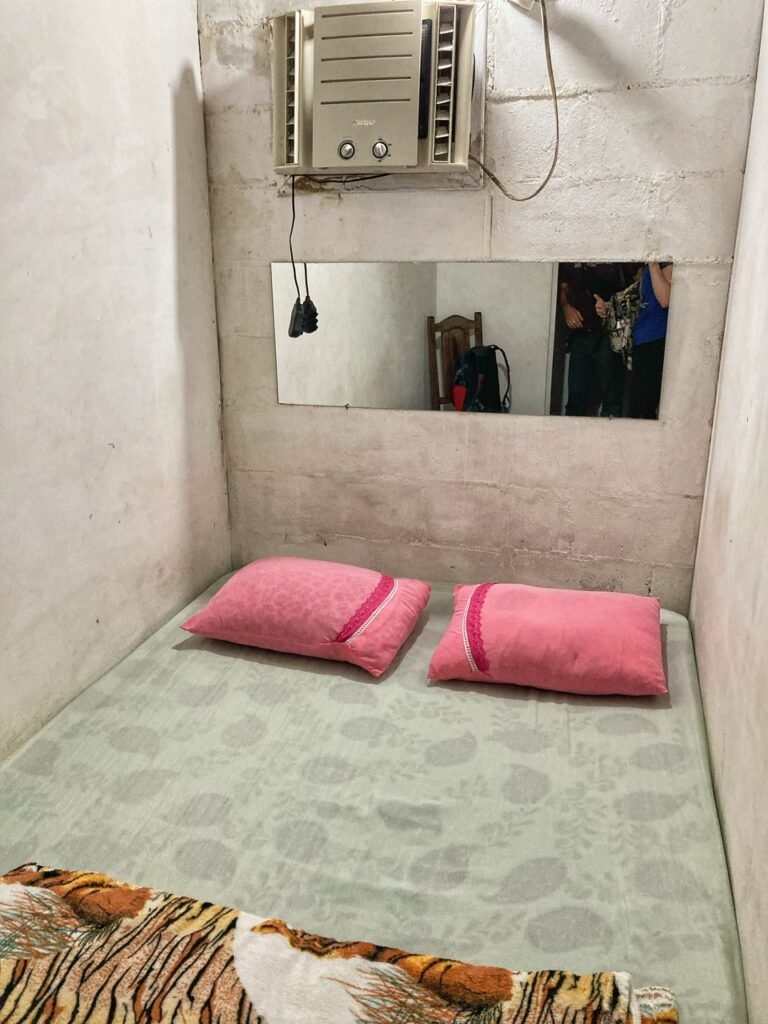
And finally, we arrived to lovely Mangaratiba just as the sun was setting. But alas, it continued. Let’s just say that getting places on a budget seems to a little more…uh…work in Brazil. Thus, we found ourselves at “Valeria’s Quartos” for 60 ríales or $12.68. It was basically a cinder block room with a concave mattress made of foam. The kind of foam that soaks in your body heat and then tosses it back in your face creating our second sweat pit of the day. But, graciously we appreciated the AC in the room, as we slipped into our blessed sleep sheets, which we thankfully always carry, after an unsavory food cart sandwich and a cheap beer.
After very little sleep, a new day couldn’t arrive soon enough! We avoided taking a shower at Valeria’s, (knowing we would have gotten electrocuted among other reasons) and practically bolted out the door at 6:30 to head towards town.
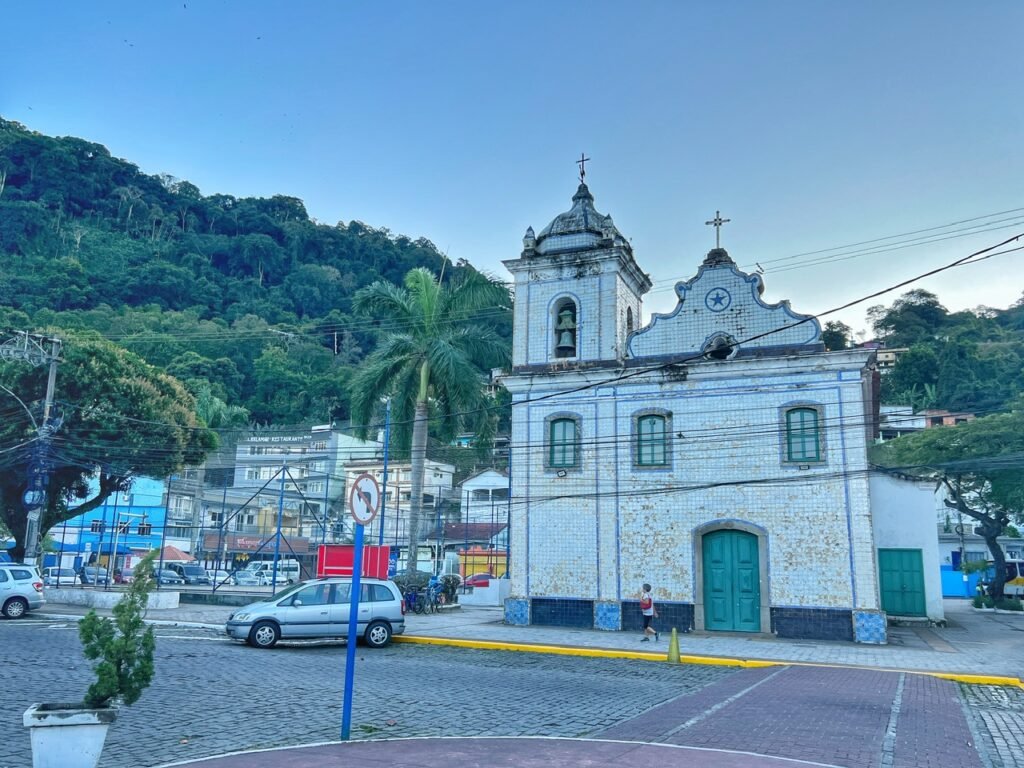
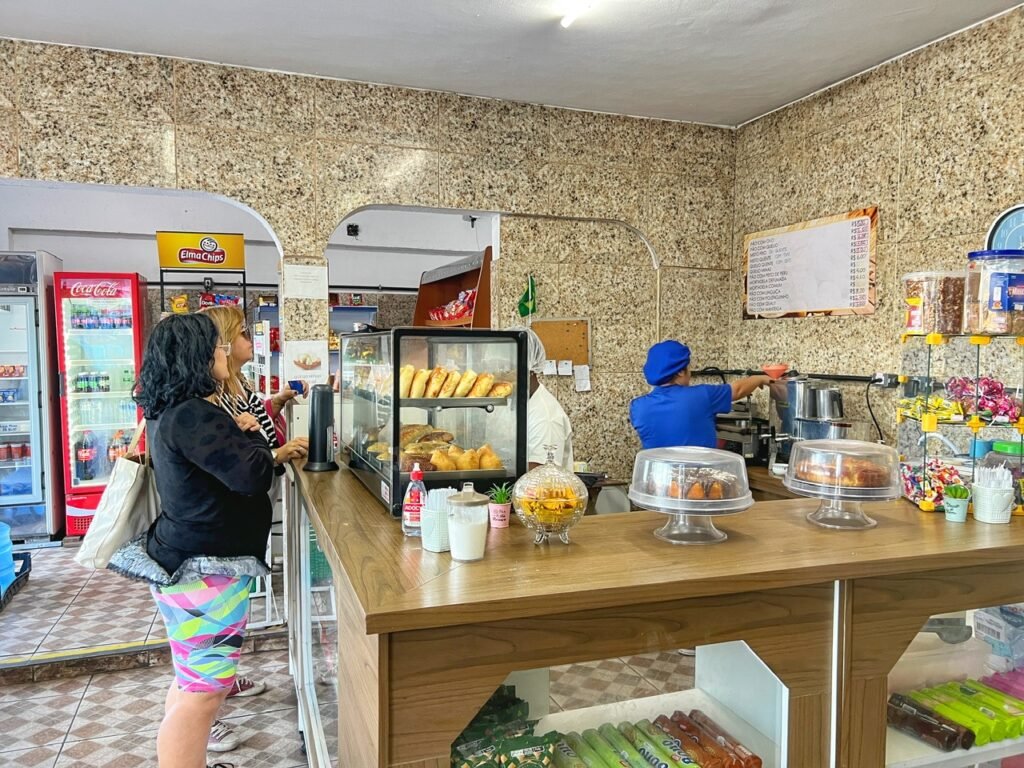
Before hitting the ferry tickets, we grabbed some breakfast at the grocery story (yogurt and banana) and a mandatory cup of coffee for Greg. …and had a look around.

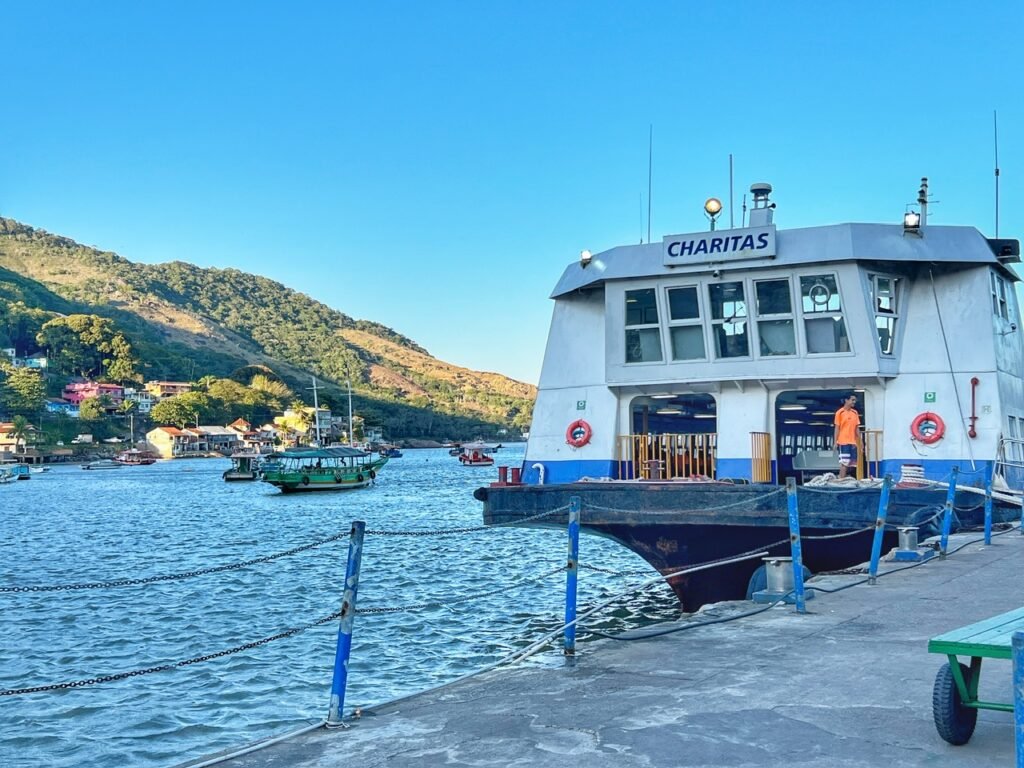
Our ferry, the only daytime ferry, was scheduled at 8 am. Most tourists go to Angra dos Reís and pay $21 a ticket. The one here in Mangaratiba cost $5/each. We’d read reviews about the rusty condition of the boat and questioning its integrity, but seriously it was fine. Whoever wrote those reviews clearly had never had a day like our day yesterday. It may have been a bit “vintage,” but it felt practically palatial to us 😁
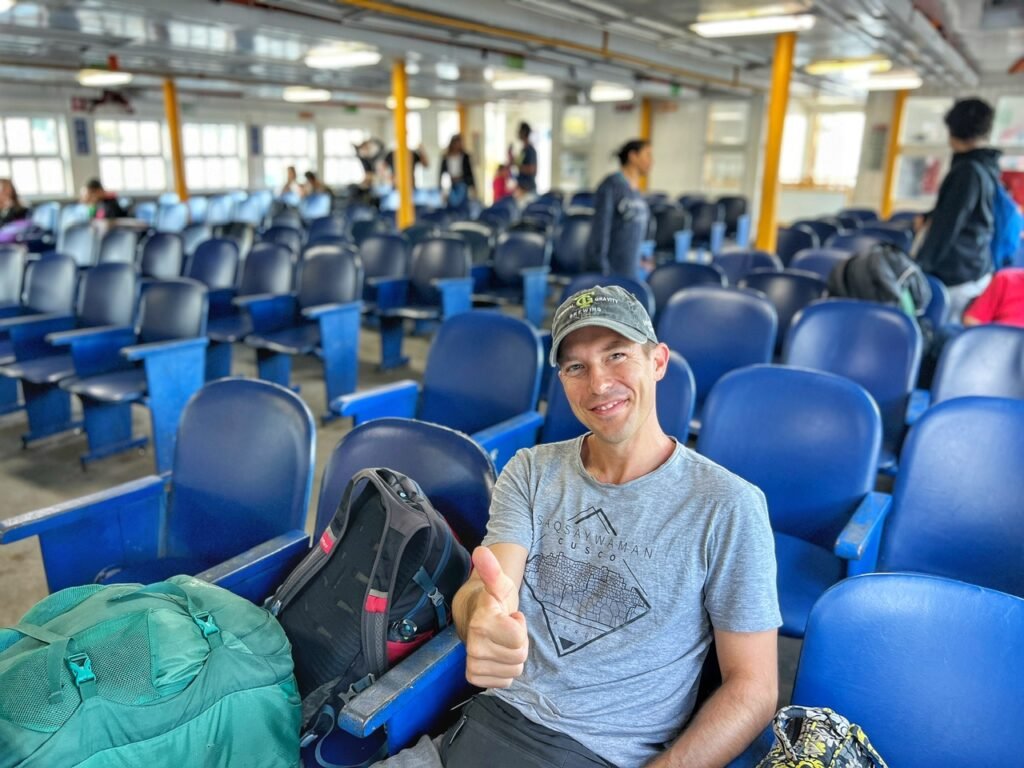

Somewhere in “The Atlantic Ocean” 🤣 (It was only a 1.5 hour boat ride from the main land)

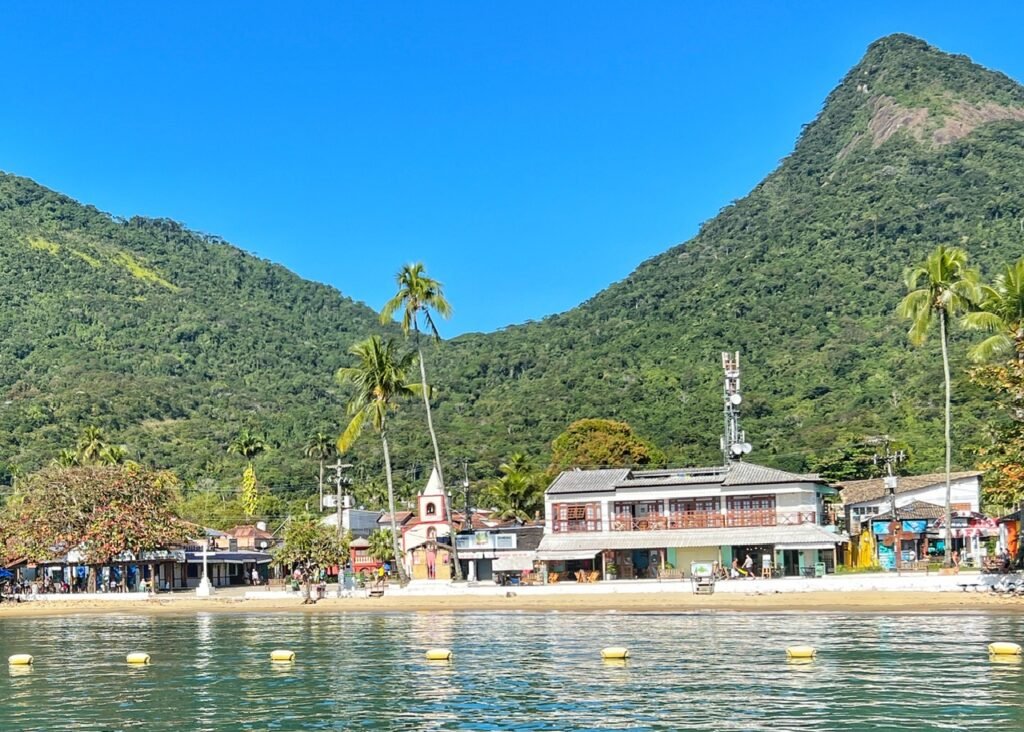
We are always grateful to have days like this because it truly keeps us humble and appreciative of our lives. If we just did things the “easy” way, we’d lose the essence of why we travel, (and money 🤣) But alas, by the time we arrived to Ilha Grande we were so ready to get back on track!
Our Accommodation

Our Airbnb on Ilha Grande for five nights was certainly an upgrade from our Brazilian trucker stop. 🤣 Our little apartment included a full kitchen, outdoor seating area, bathroom with semi-hot water, outdoor shower and a surprisingly friendly black cat. (Black cats are normally moody and aloof we’ve discovered, but not this one!)
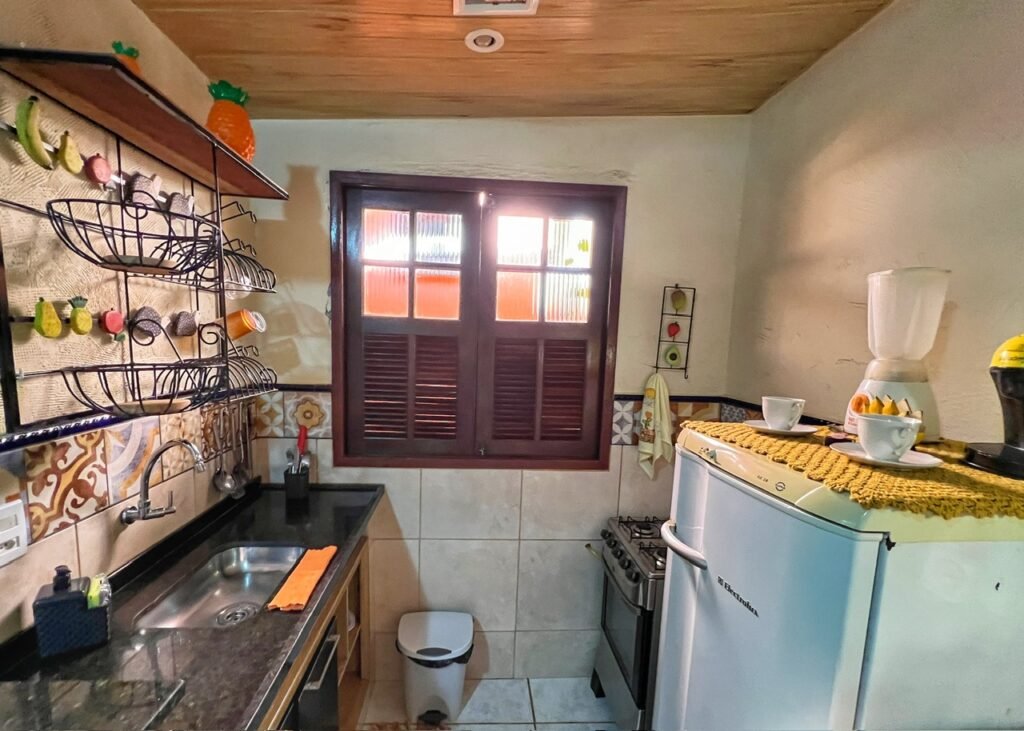
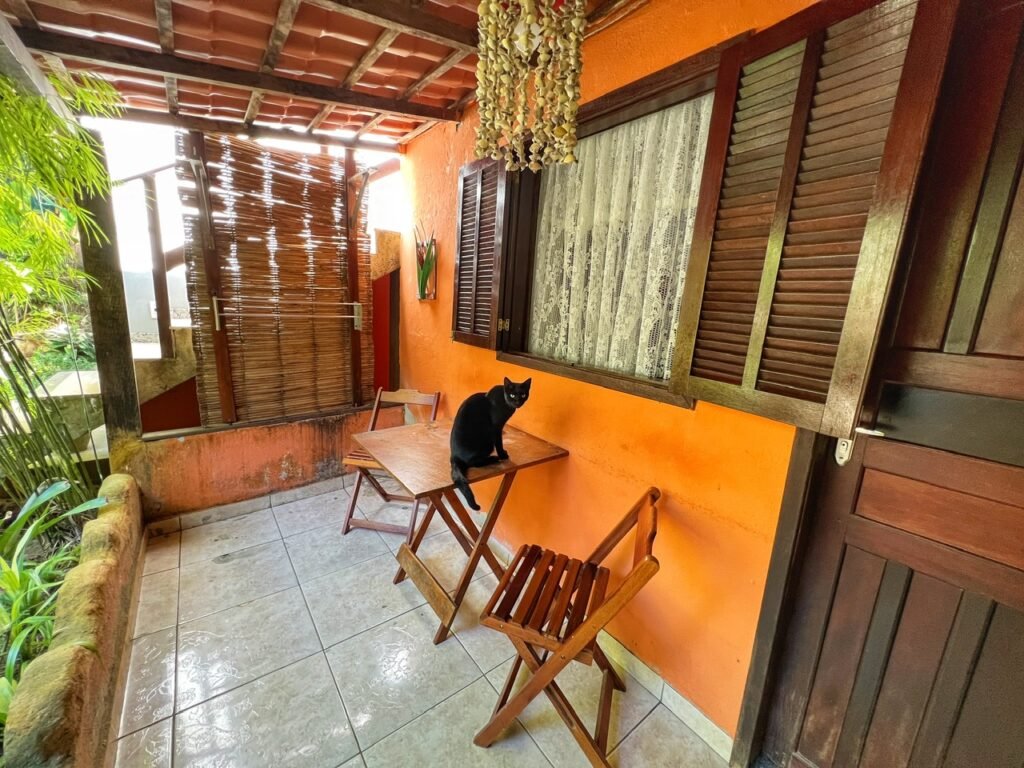
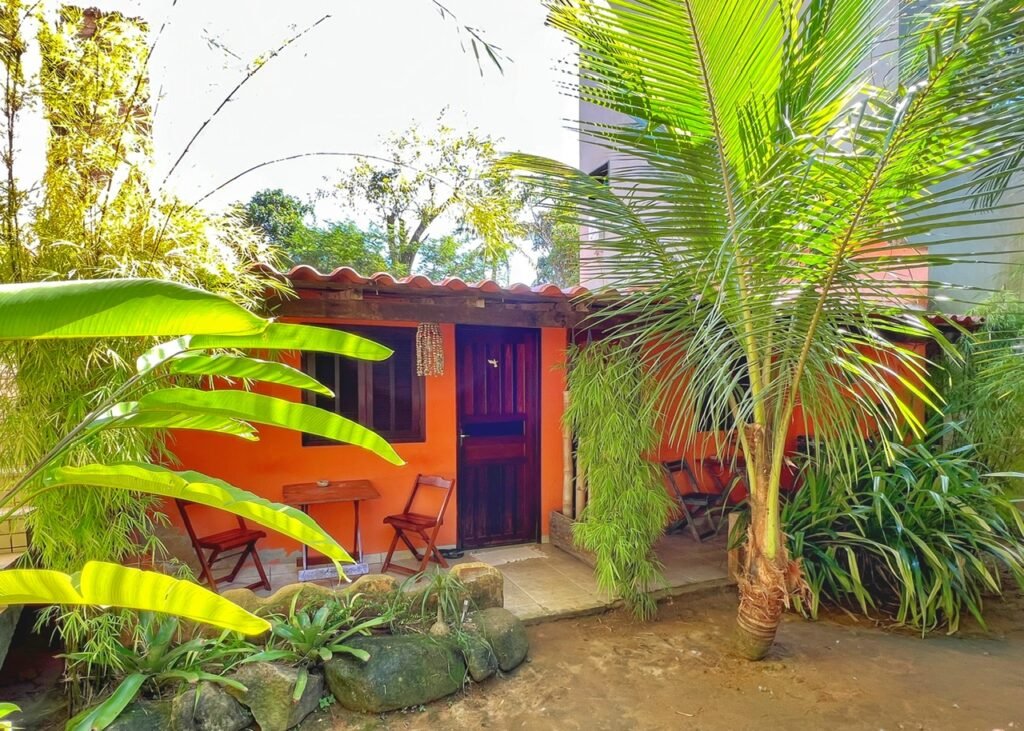
We were about two blocks from the town and the beach, and it was incredibly tranquil and inviting. The bird song that woke us up every morning was so incredibly sweet as well.
The Southeast Beaches
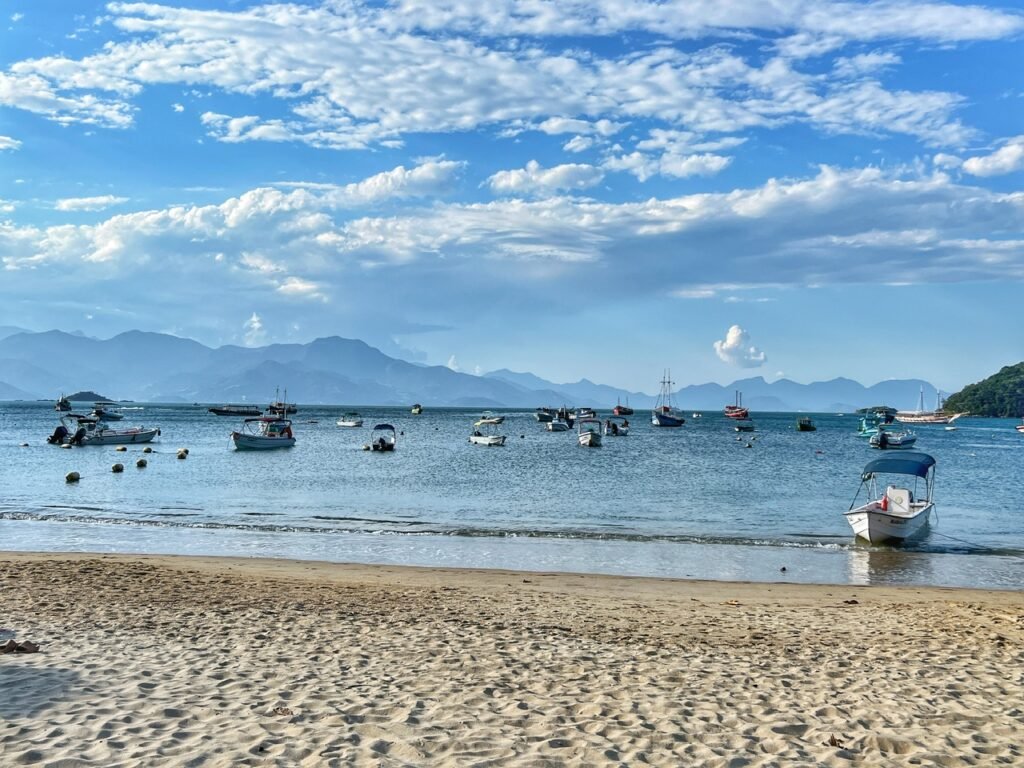
Once we got through the “trauma” of arriving to Ilha Grande, we knew immediately that the car and motorized vehicle-free utopia of Ilha Grande is our kinda place…made for walking. Our first day we clocked 25,000 steps hiking round trip from our doorstep to “one of the top ten most beautiful beaches in Brazil.” Considering Brazil has a gorgeous beach at every turn, this seemed like a considerable and completely subjectively distinction. It was indeed beautiful, but we found the beaches we walked through en route just as enticing, although perhaps the sand wasn’t as powdery perfect, nor the waves swelling, as on 3-kilometer long Lopes Mendes.
After a loaded bowl of oatmeal and arranging a carefully packed day bag (lunch, lots of water, sunscreen, change of clothes, towel), we departed our pad at 10:00 to step onto the beach nearest our place, Praia do Canto, which took about five minutes in the town of Abraão. This beach is always loaded with boats from all over floating in the harbor. In the distance, the mountainous mainland of Brazil completes the postcard.
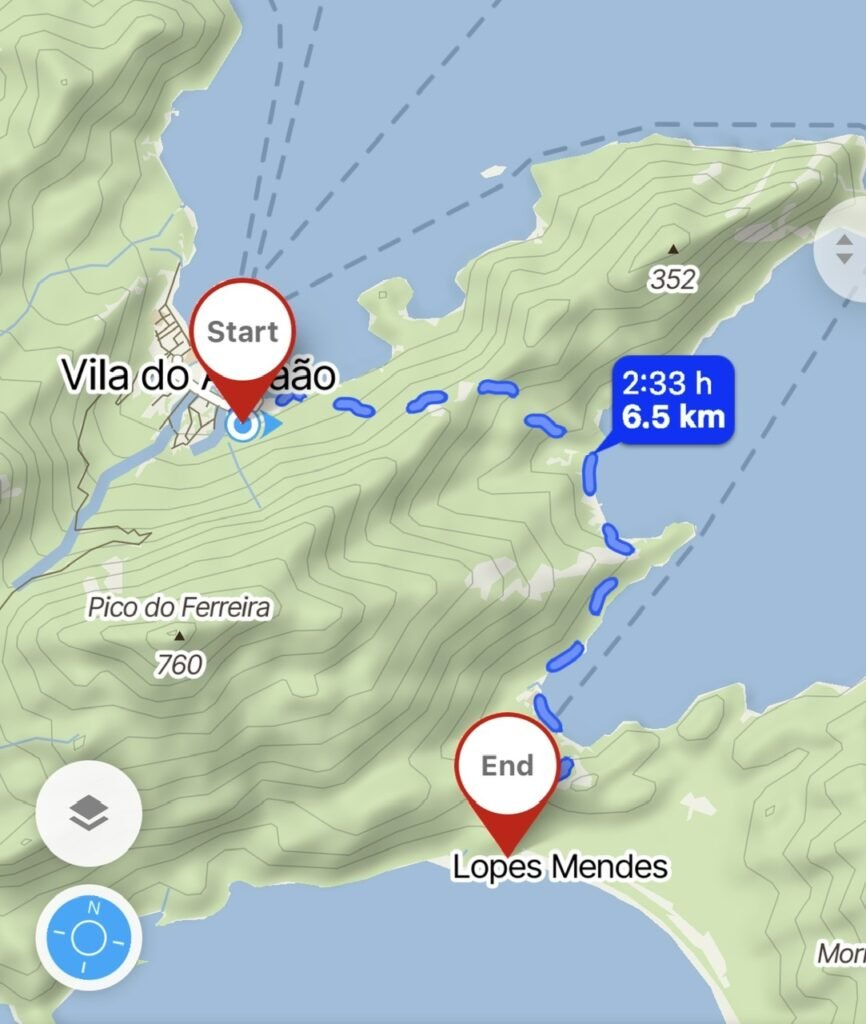
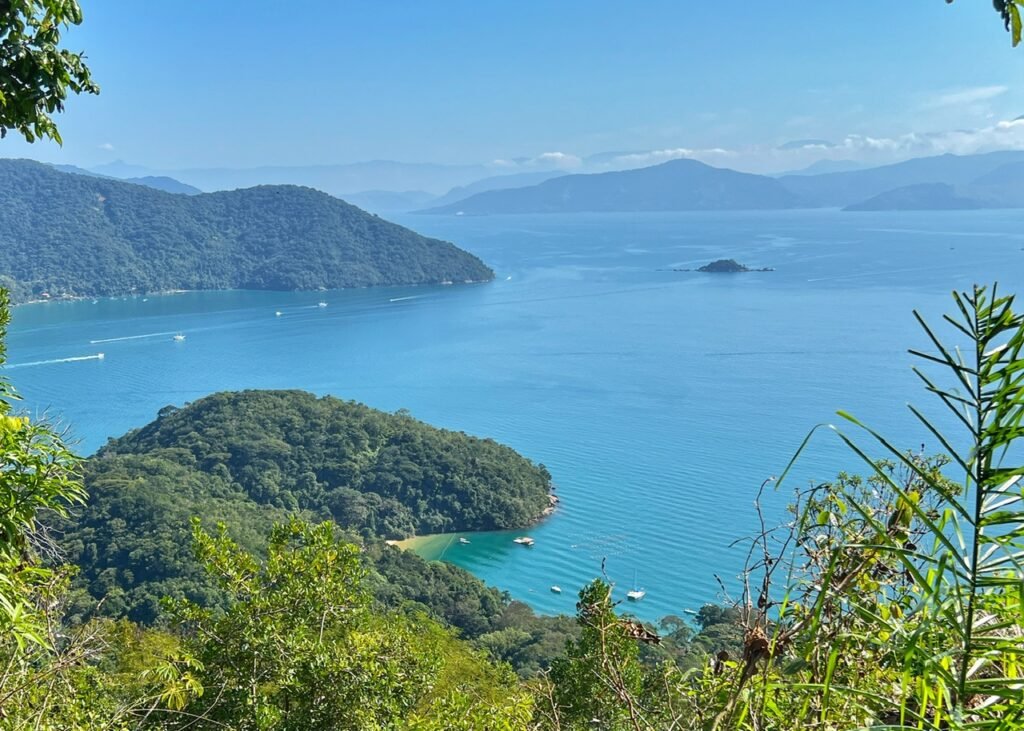
The 6.5 km (2.5 hour) one way hike to Lopes Mendes was a relatively easy/moderate hike and took you up into the jungle, down again and alongside many beaches and lookouts. (Mapy.cz app) The trail is also very well marked. We arrived back to Abraão just as the sun was starting to dip at around 5:30.
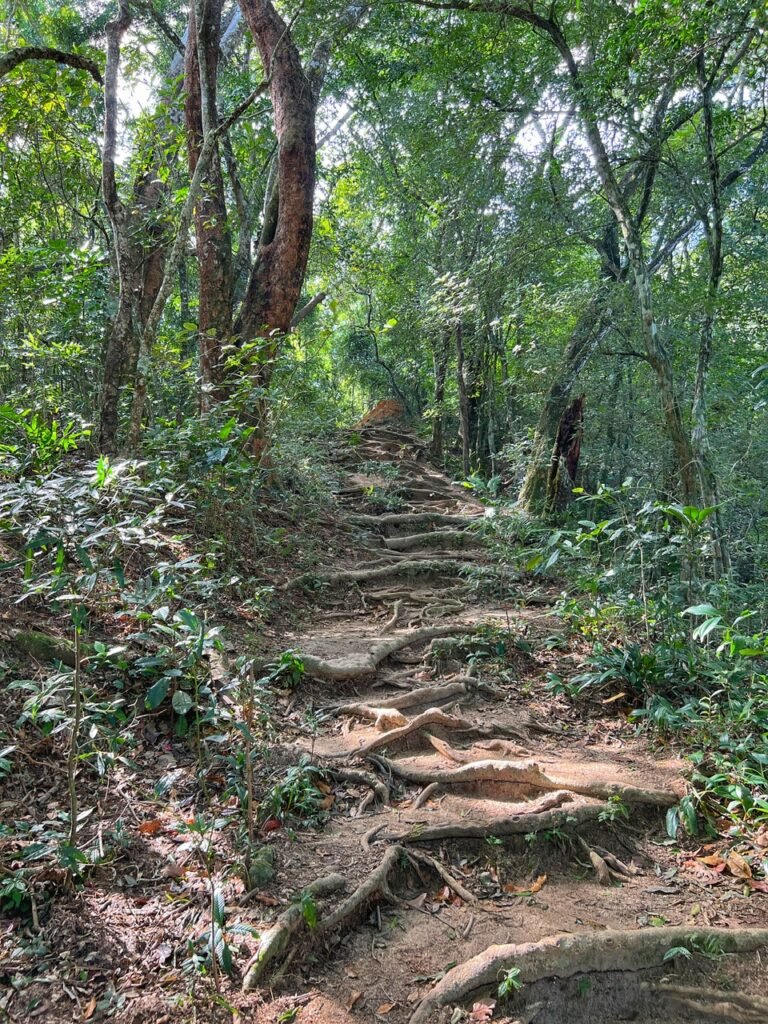
Much of the trail was gnarled and hiker friendly though you definitely had to watch every step.

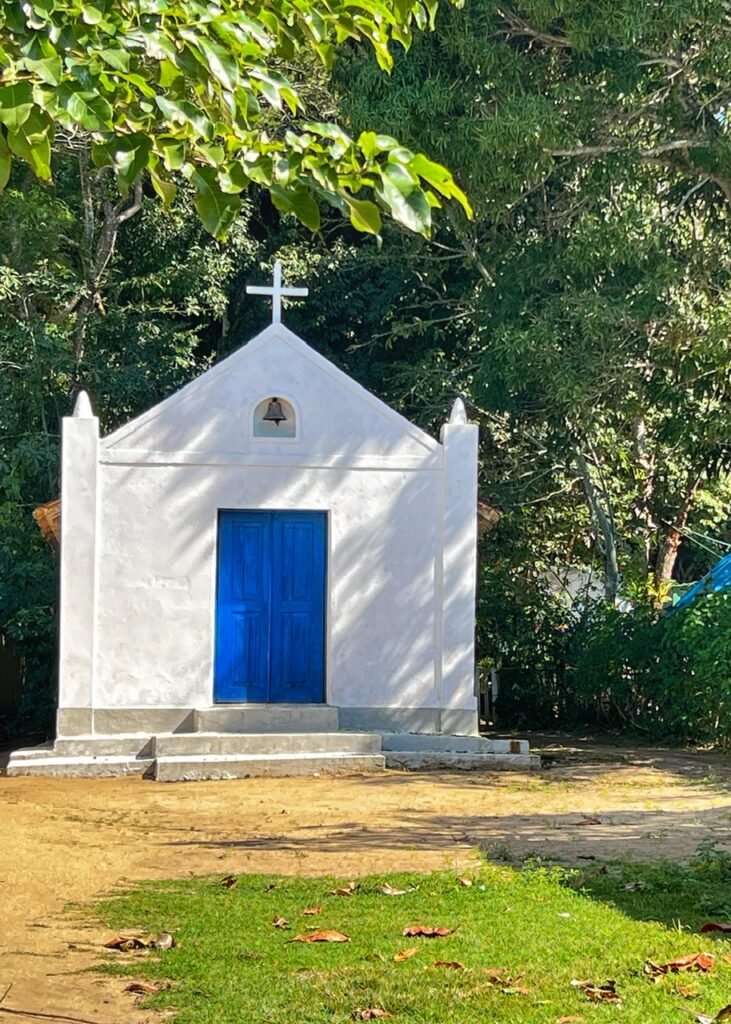
Arriving to the second beach of the day, Palmas with golden sand and tranquil water, as well as a mini Greco-esque chapel.

It was lined with shady and inviting almond trees.
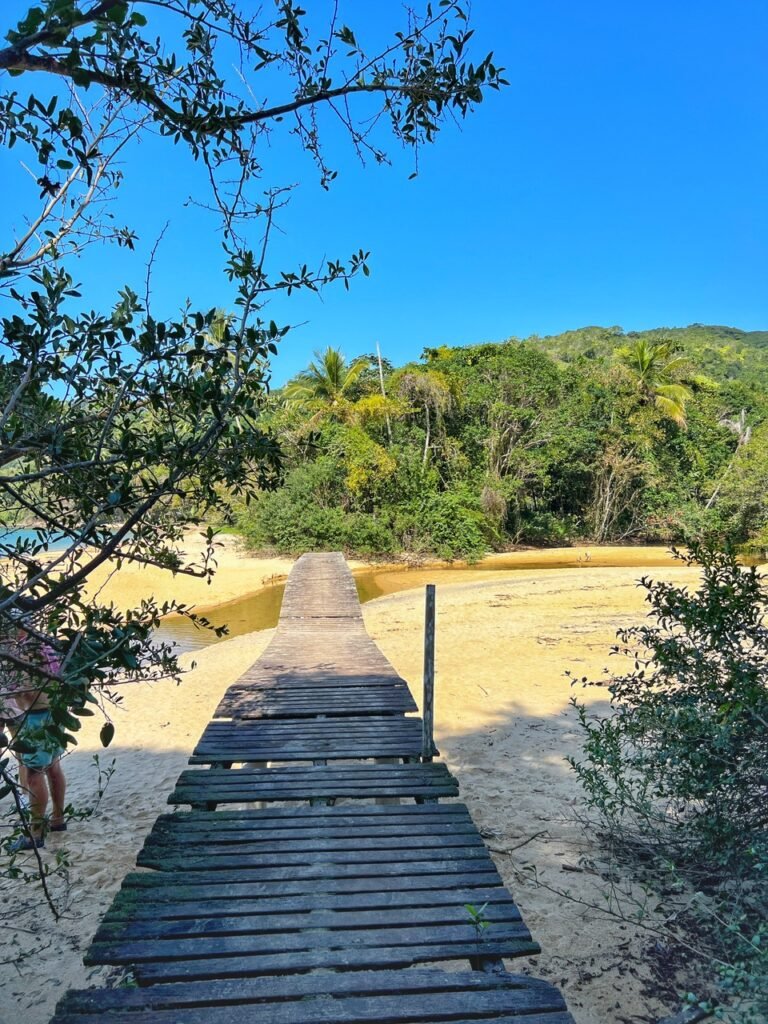
Arriving to the third beach, we encountered a bridge to nowhere, which would have been helpful because we did have to cross the ankle deep outlet. Mandy plunged through with the shoe-on approach and Greg, the always more patient one, removed his shoes and socks and then dealt with the wet sand plastered to his feet on the other side.
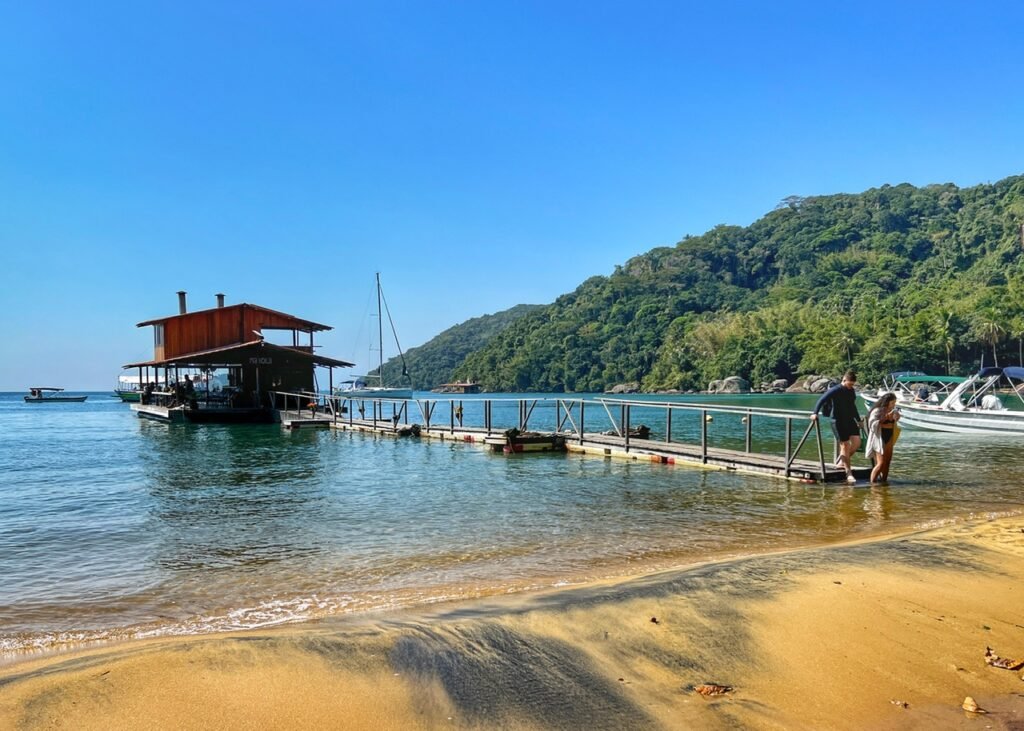
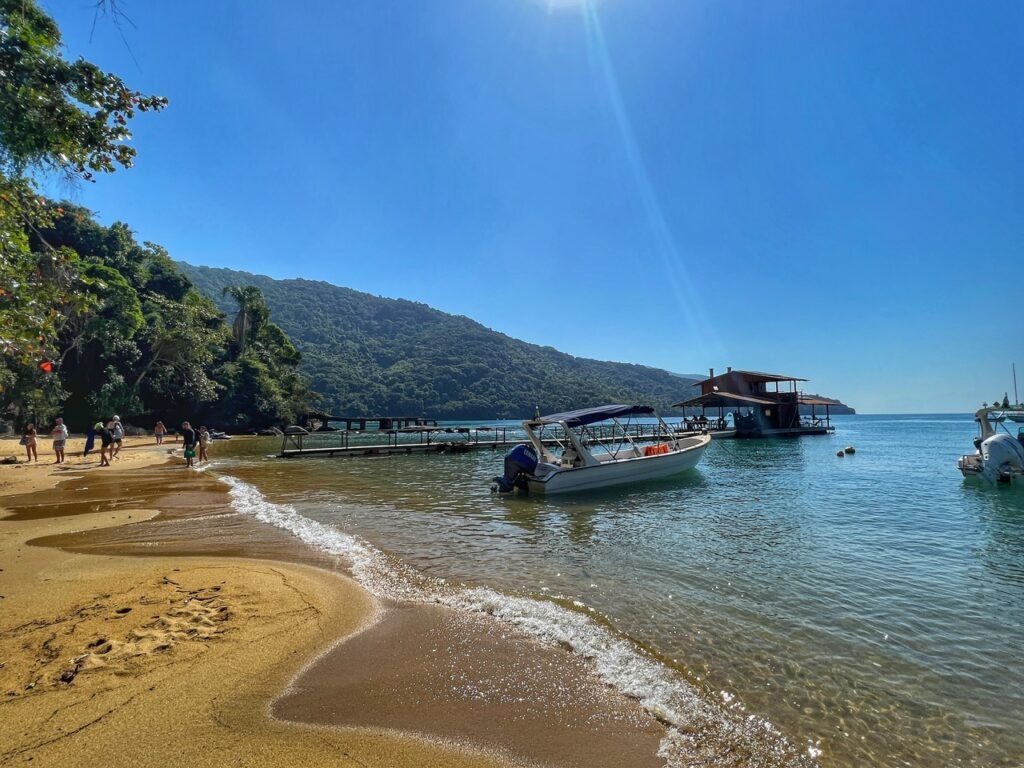
This beach, called Pouso, has the most options for food, including a floating restaurant. If you prefer to float, rather than walk back, or not walk at all, you can take a water taxi to and from this beach for around $8/person. But, of course we chose to walk.
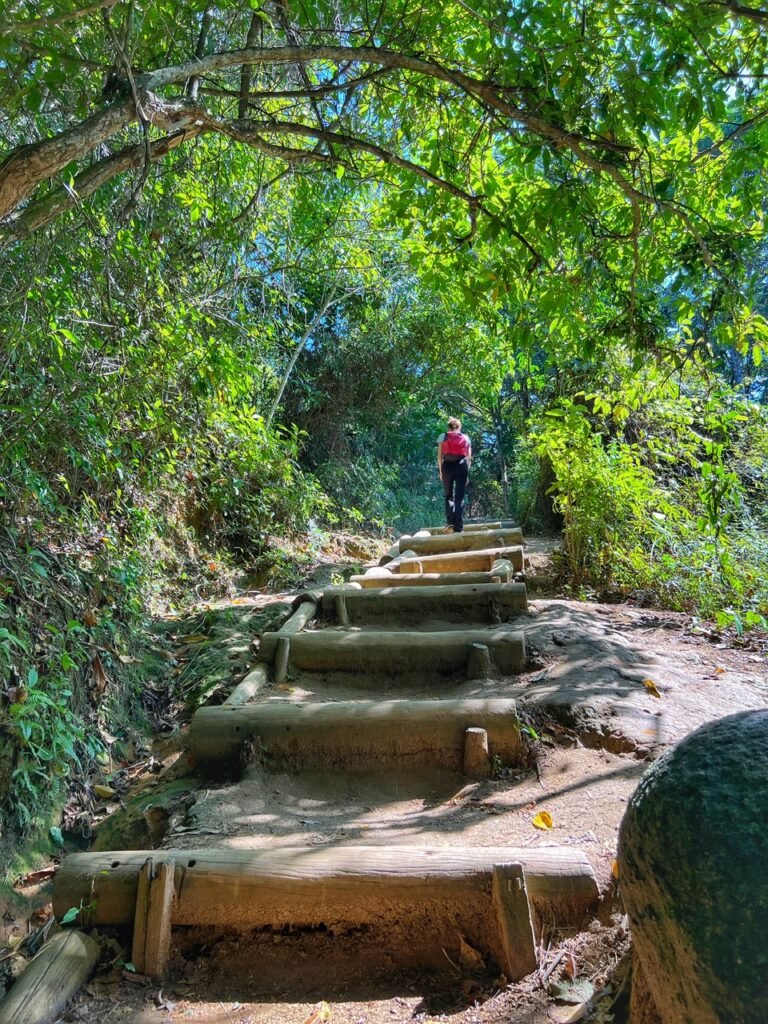
Up we go from a beach again.
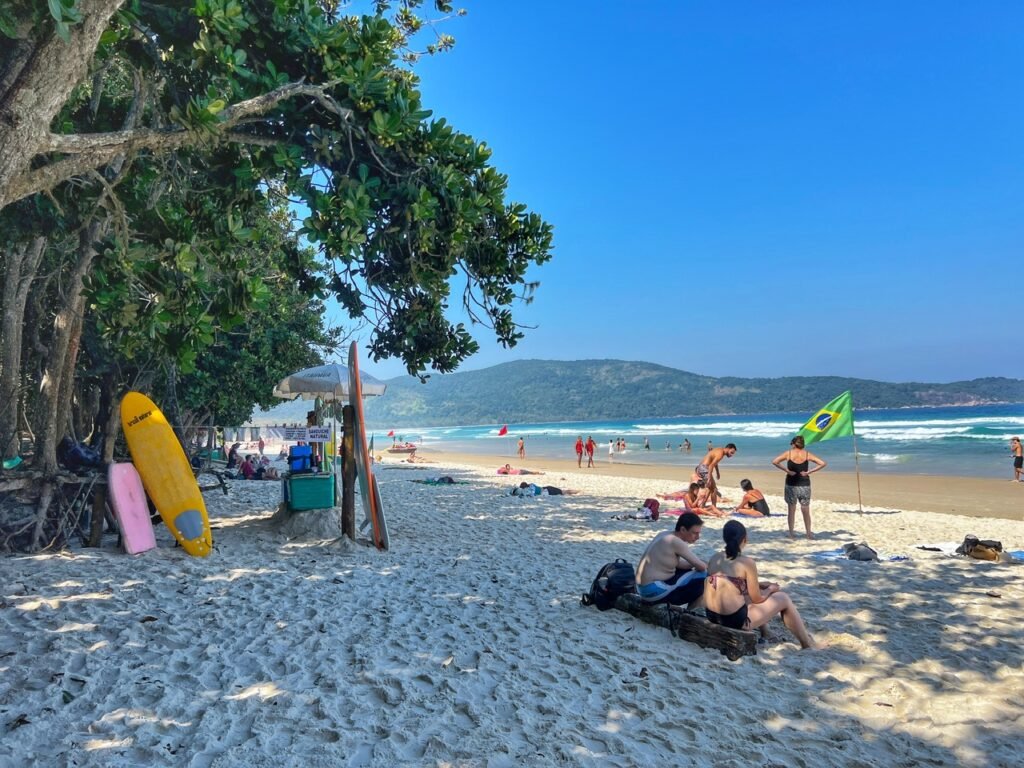
And, about twenty minutes later, back down…to arrive to our wild sea churning, wave pounding destination of Lopes Mendes, which is the first of the beaches open to the Atlantic. It was surprisingly full of people considering we’d seen so few on the trail. Guess they all took the water taxis!
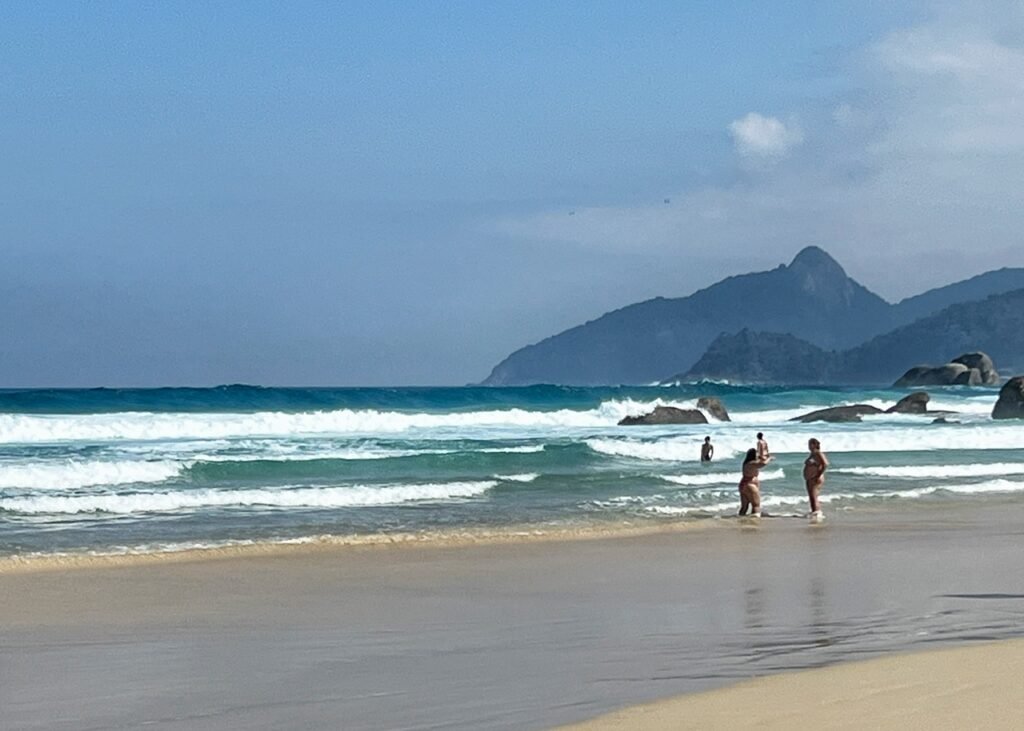
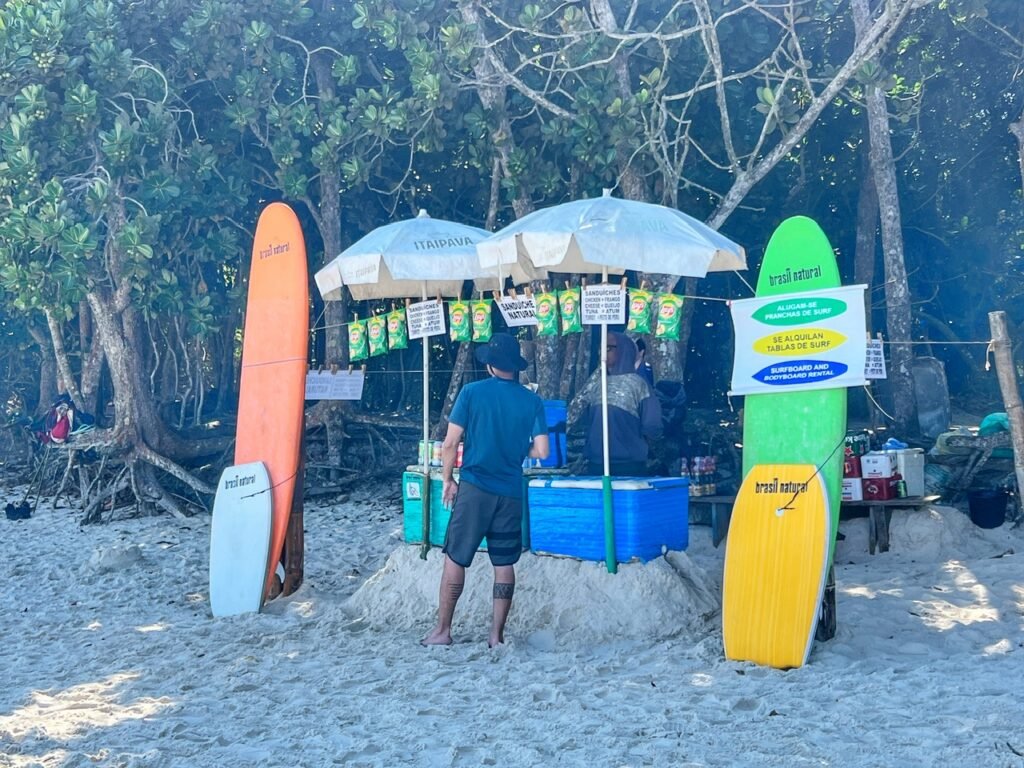
We grabbed a large Brahma beer for 12 ríales ($2.50) from one of the few vendors and plopped down on our towel to enjoy it and hoover up our sandwiches, while enjoying the view.
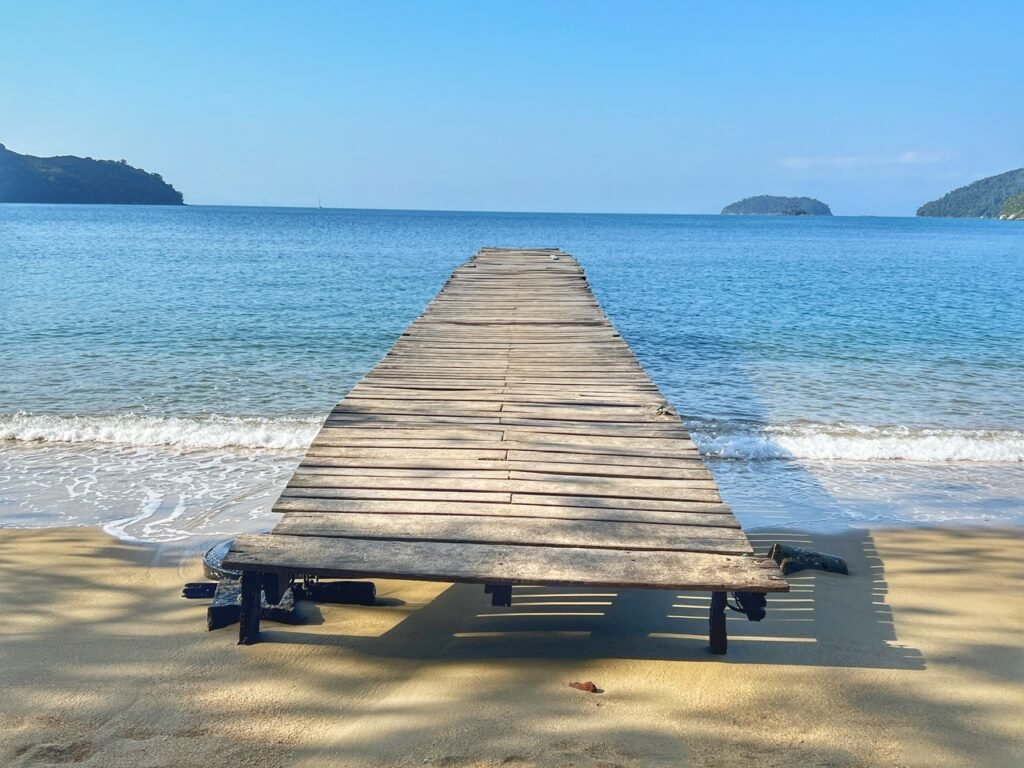
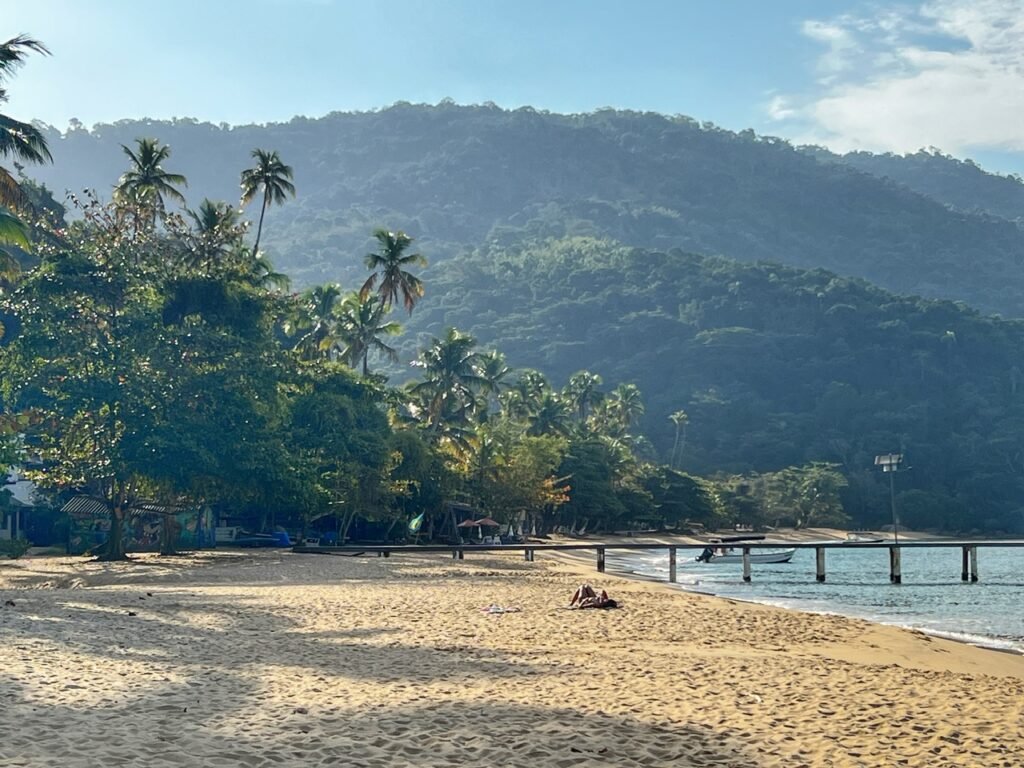
We lasted about two hours before getting bored and then started to head back, enjoying the scenery from utterly tranquil Pouso Beach a second time. Oh yes. This is where it’s at. ❤️
The Village of Abraão
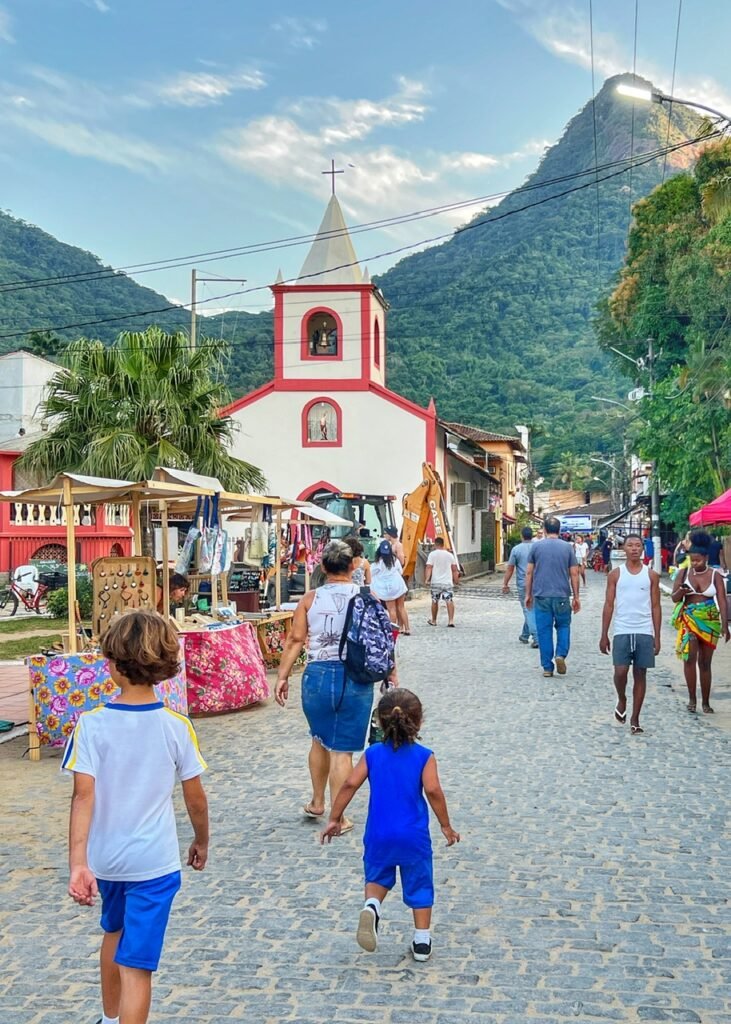
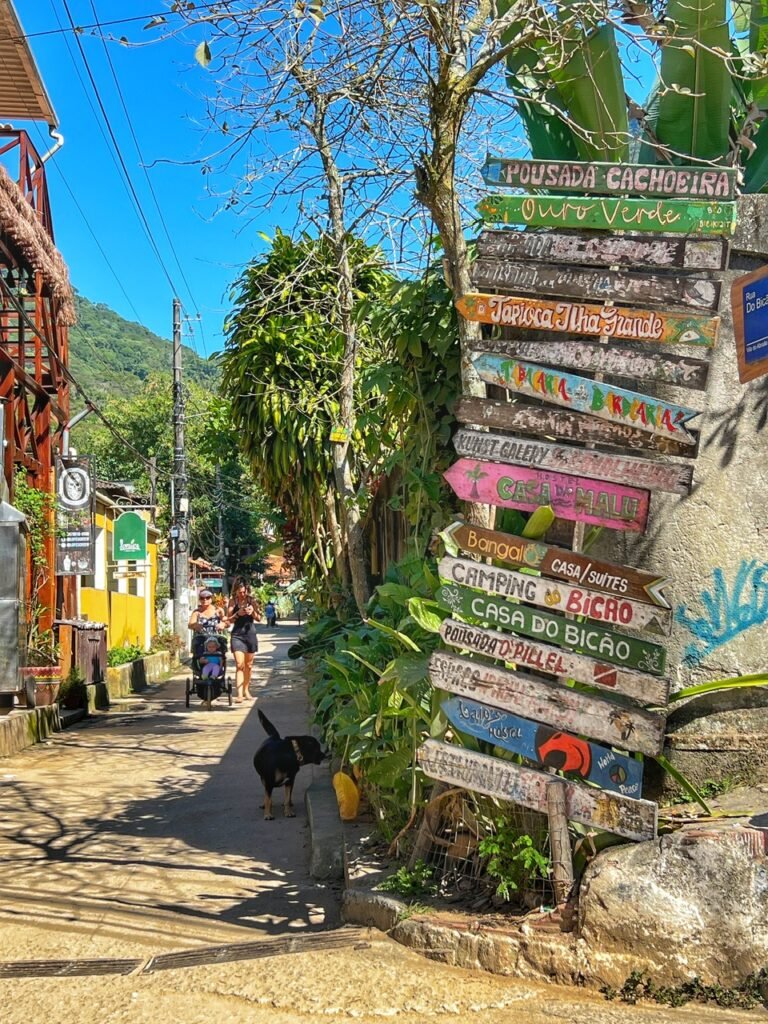
The village of Abraão is the only sizable community on car-free Ilha Grande. It’s a little buzzing hub of energy, which speaks of other backpackery type places we’ve been, but certainly with a higher price point. Still, it is by far the most economical place to stay on the island, and has access to the ferries, multiple trail options, a pharmacy, tourist services, restaurants, supermarkets and beaches—an obvious base for our jaunt to the island.
Many tourists, both Brazilians and foreigners flock to charming Ilha Grande, although we went in the winter season, which is far less crowded than summer. Prices are also much more appealing this time of year. The rhythm of the village is slow and islandy where streets are lined with cobbles or dirt and lots of colorful directional signs.

And the beach, even right in the village, is alluring and inviting.
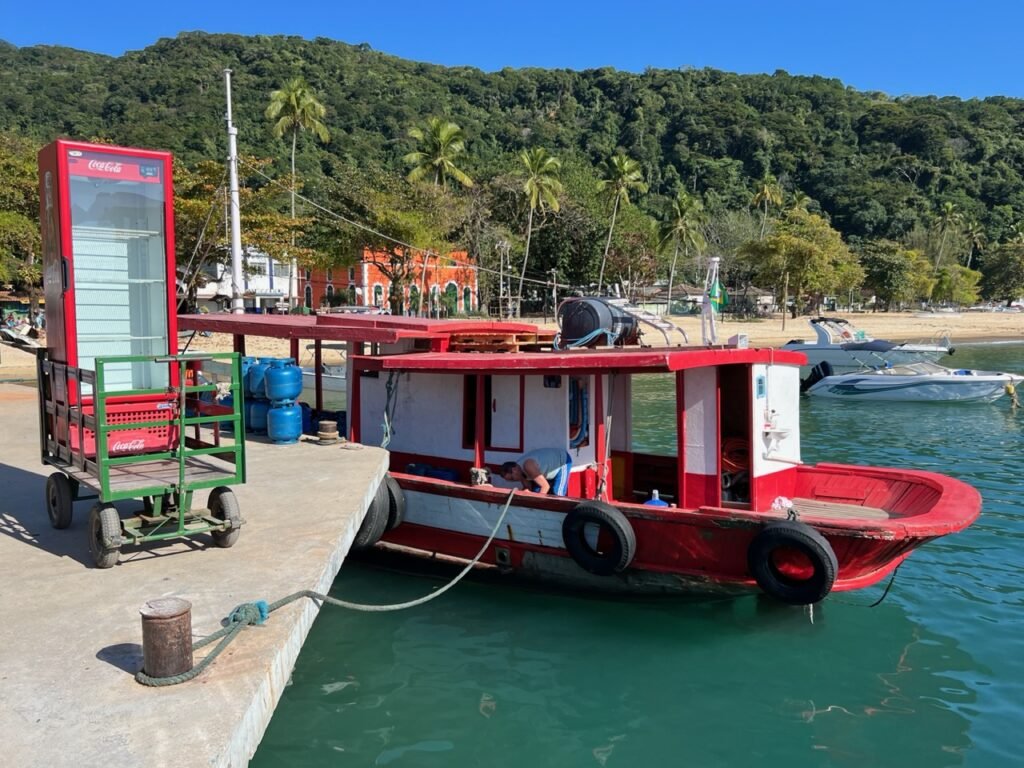
We especially loved the little pops of red.
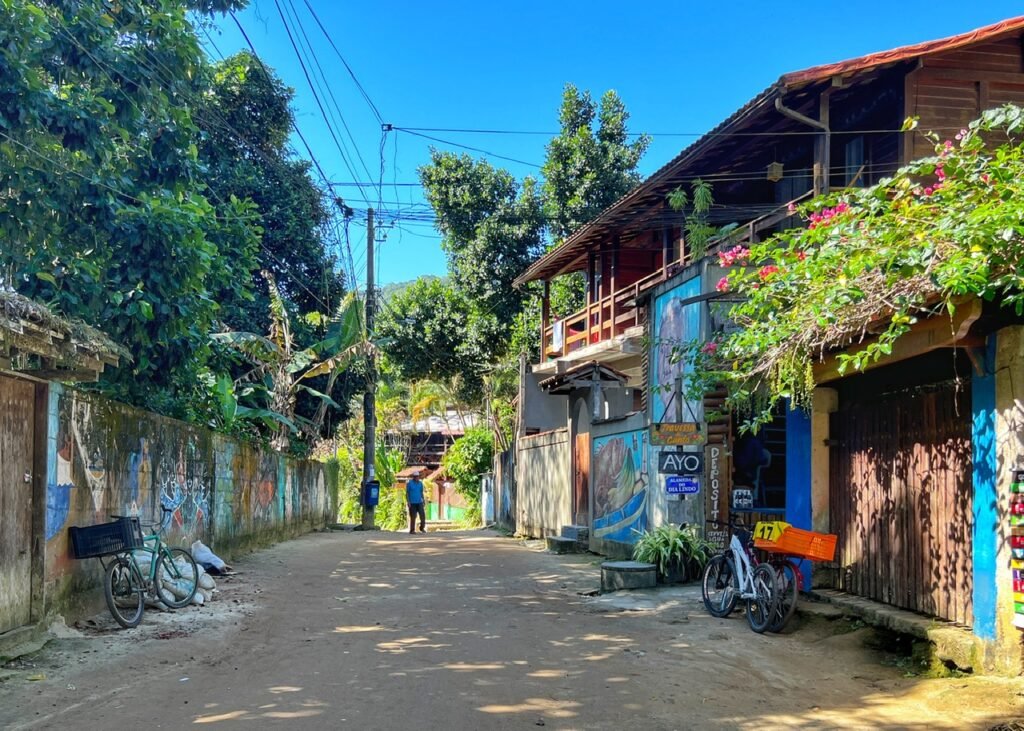
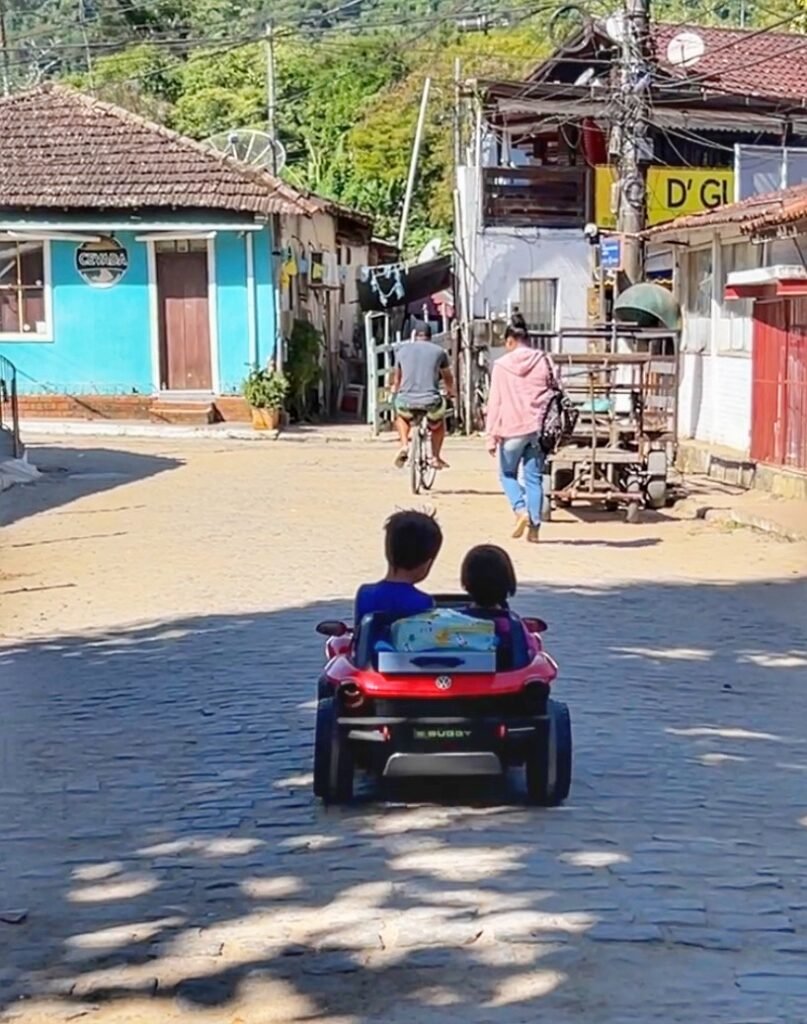
The dirt streets of the village are allowed two motorized vehicles only…the local ambulance and the local garbage truck. Otherwise, it’s full of pedestrians and bicyclists, so now sure how this little Bonnie and Clyde managed to snag wheels. 🤣 These two mischief makers were cruising around everywhere, every single time we went out!!
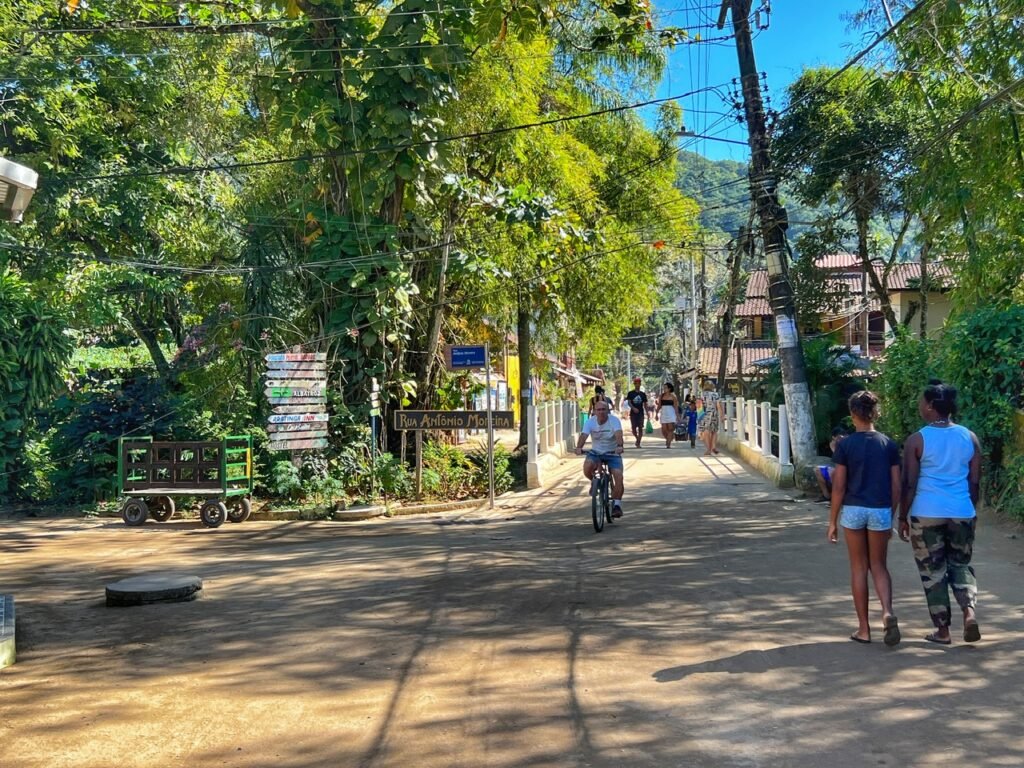
It’s an agreeable and easy way of life.
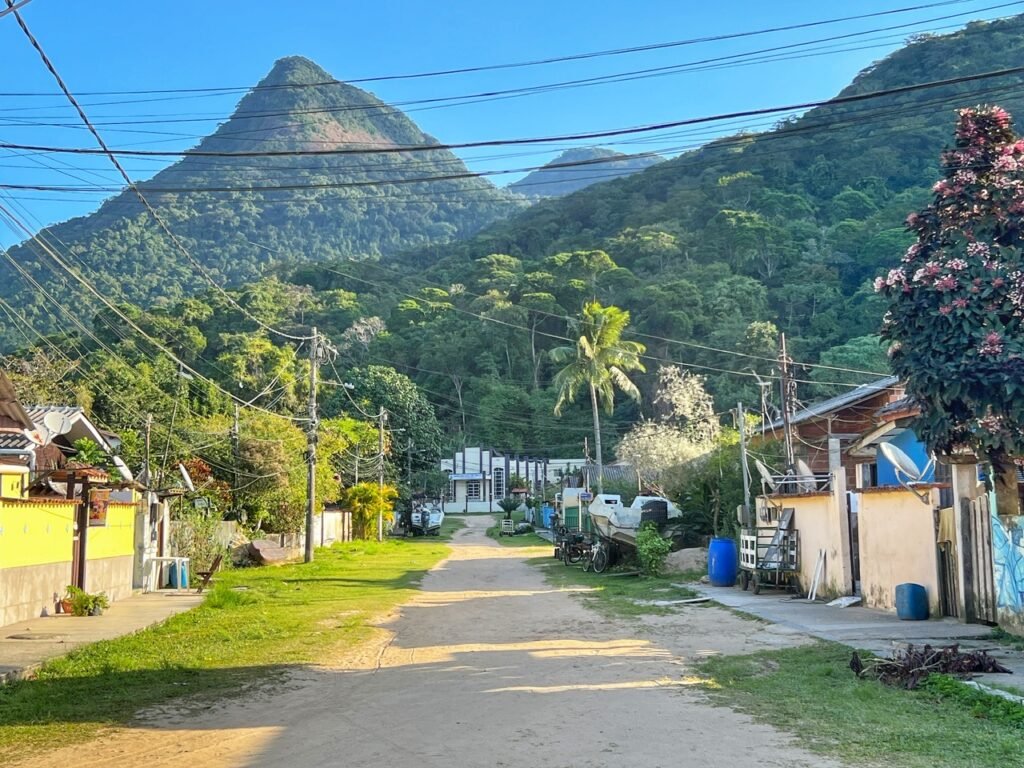
Moving into the more residential section of the town you can clearly see Pico do Papagaio, which is second highest peak on Ilha Grande. It takes about 2/3 hours to summit and due to the rainy/muddy forecast we’ve had, we’re probably gonna nix it in lieu of other hikes.
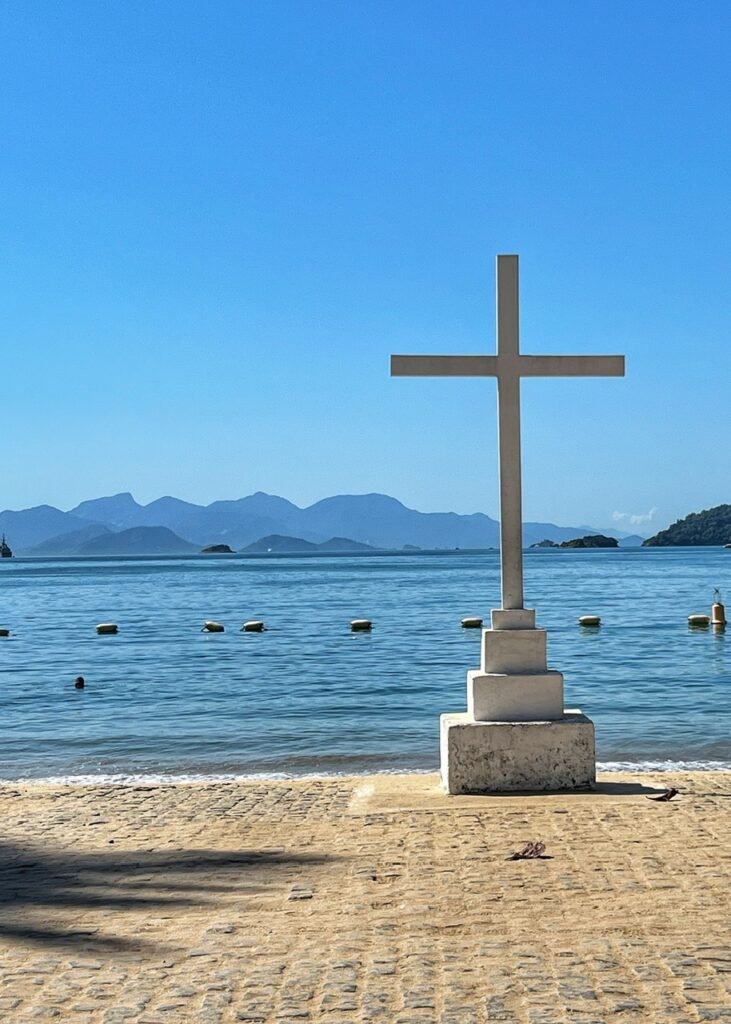
The cross which welcomes you to the island.
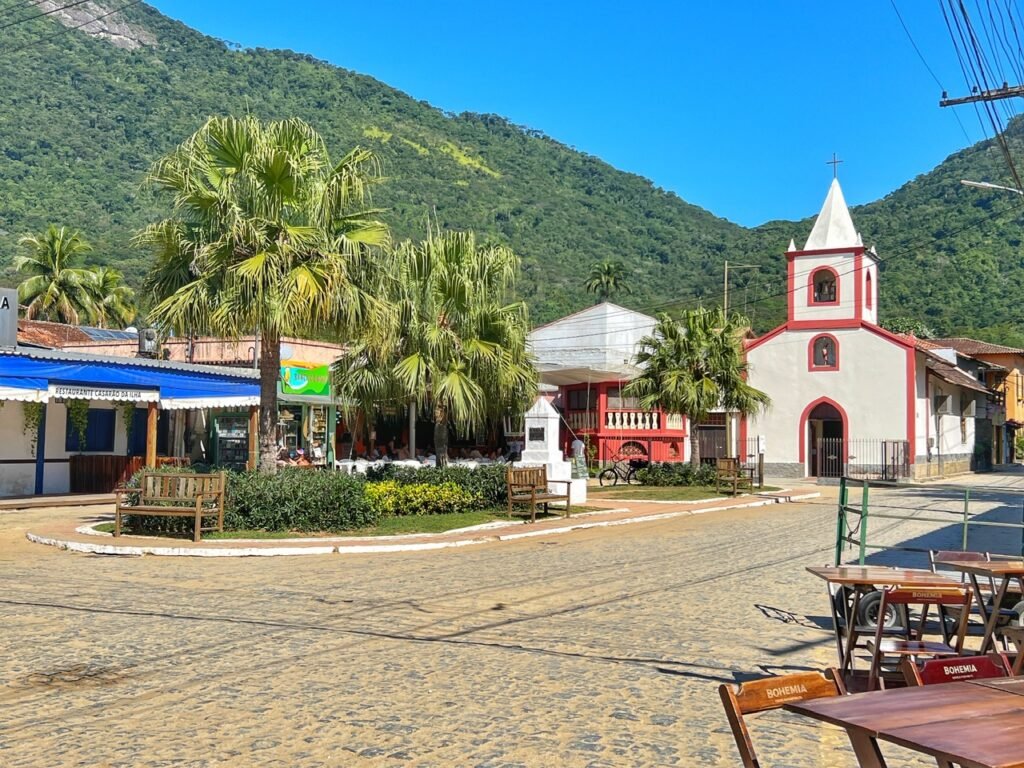
And the adorable town square.

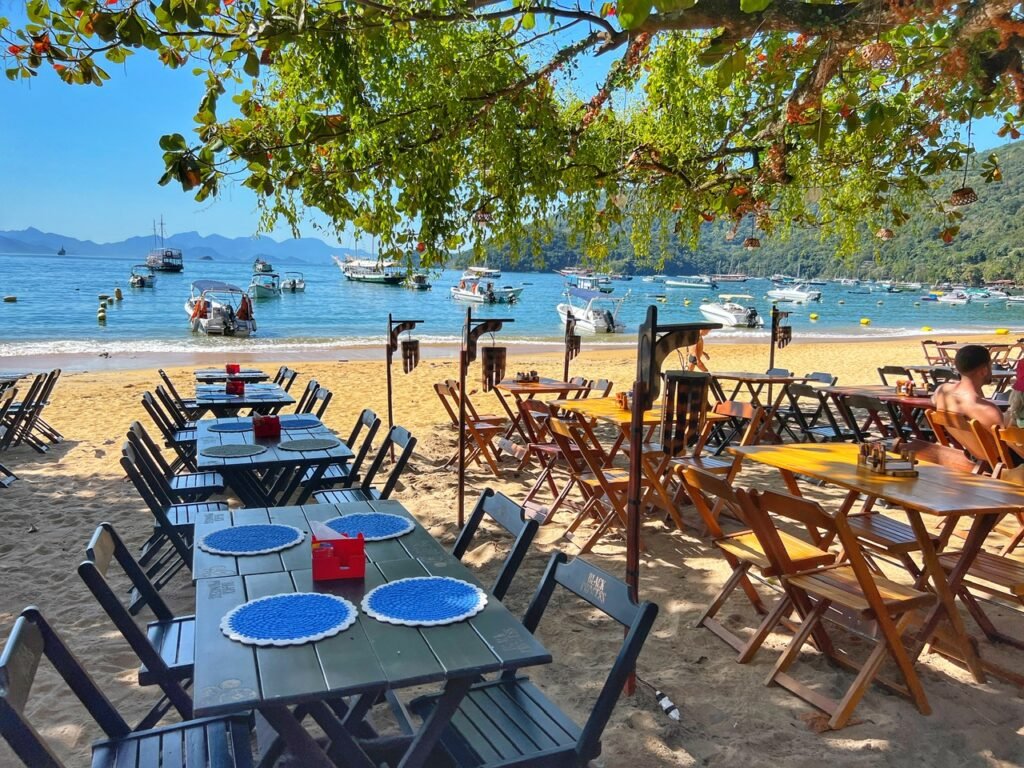
The waterfront restaurants have been pretty tame since we arrived. The rainy weekend obviously kept many locals away.
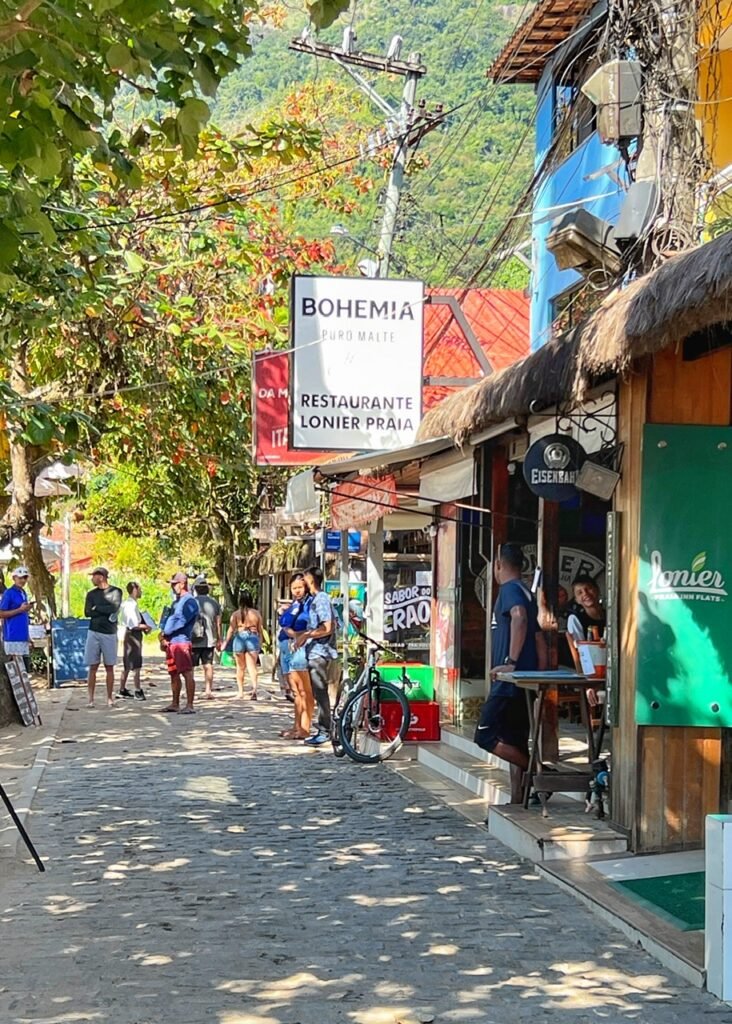
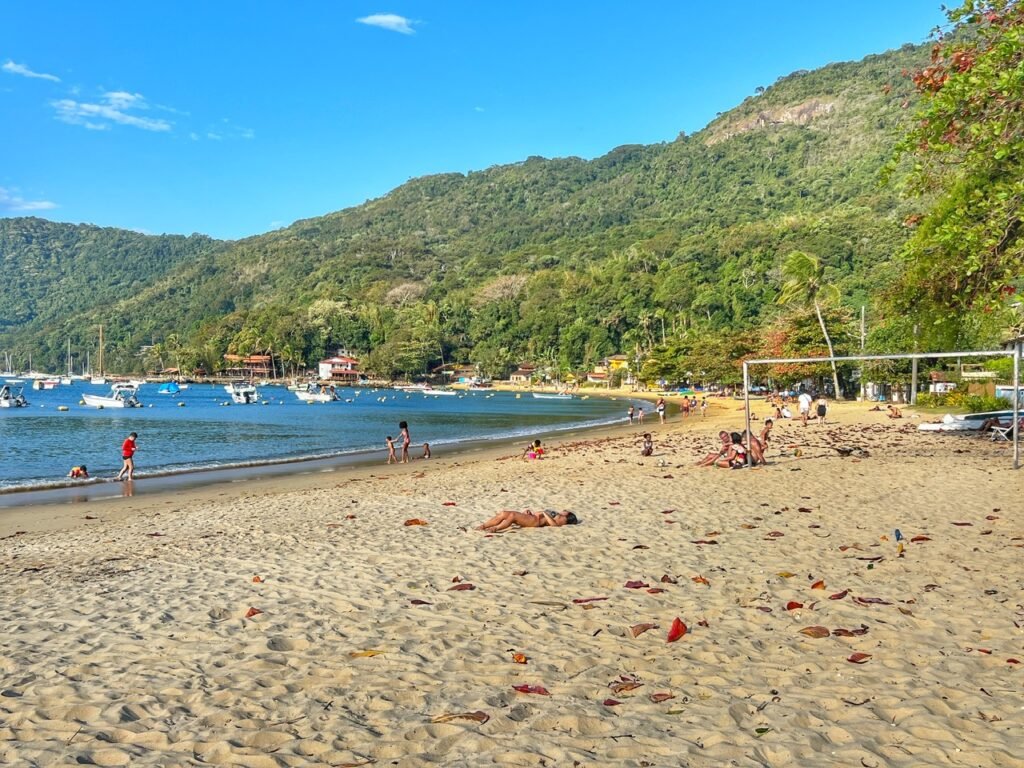
Lots of beautiful seaside dining options on the beach nearest our place. Quite pricey though we read the portions are sizable.
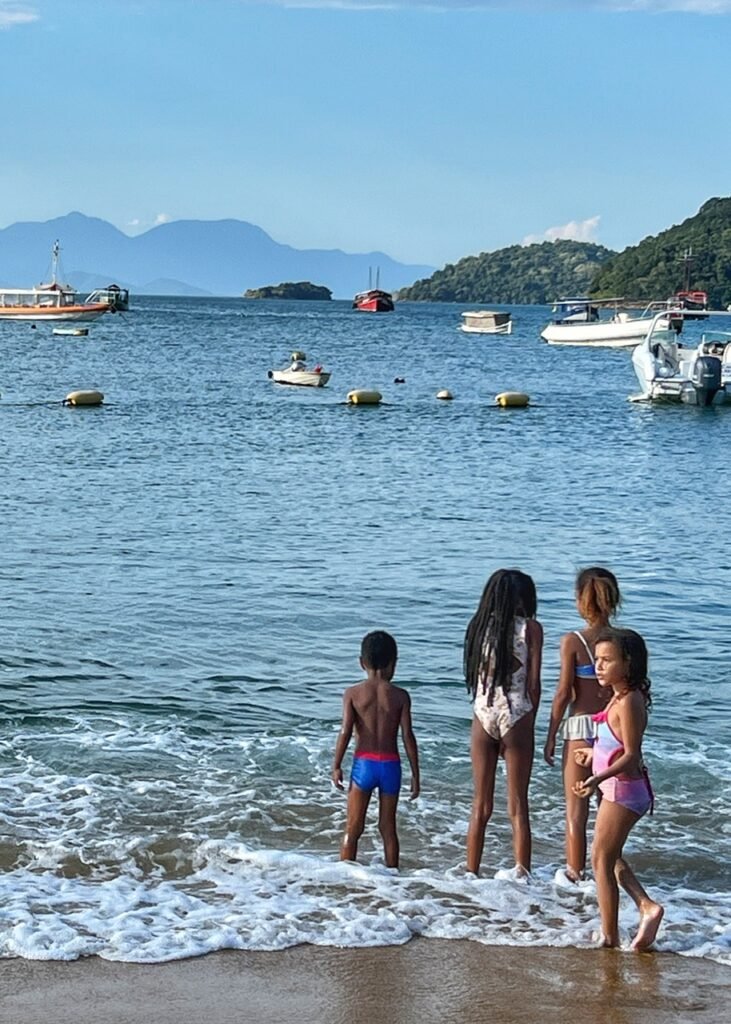
Kids, who will be kids anywhere, testing out the waters. It wasn’t that cold, but with the combined air temperature of low 70’s that day, there’s no way we were getting in. 🤣
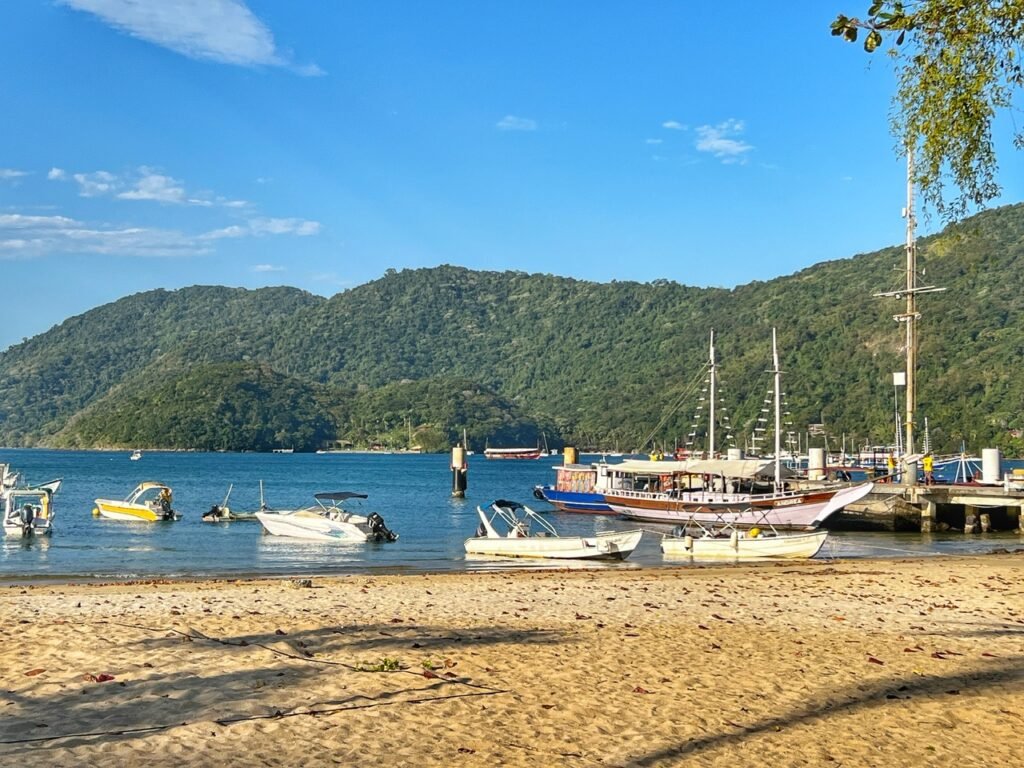
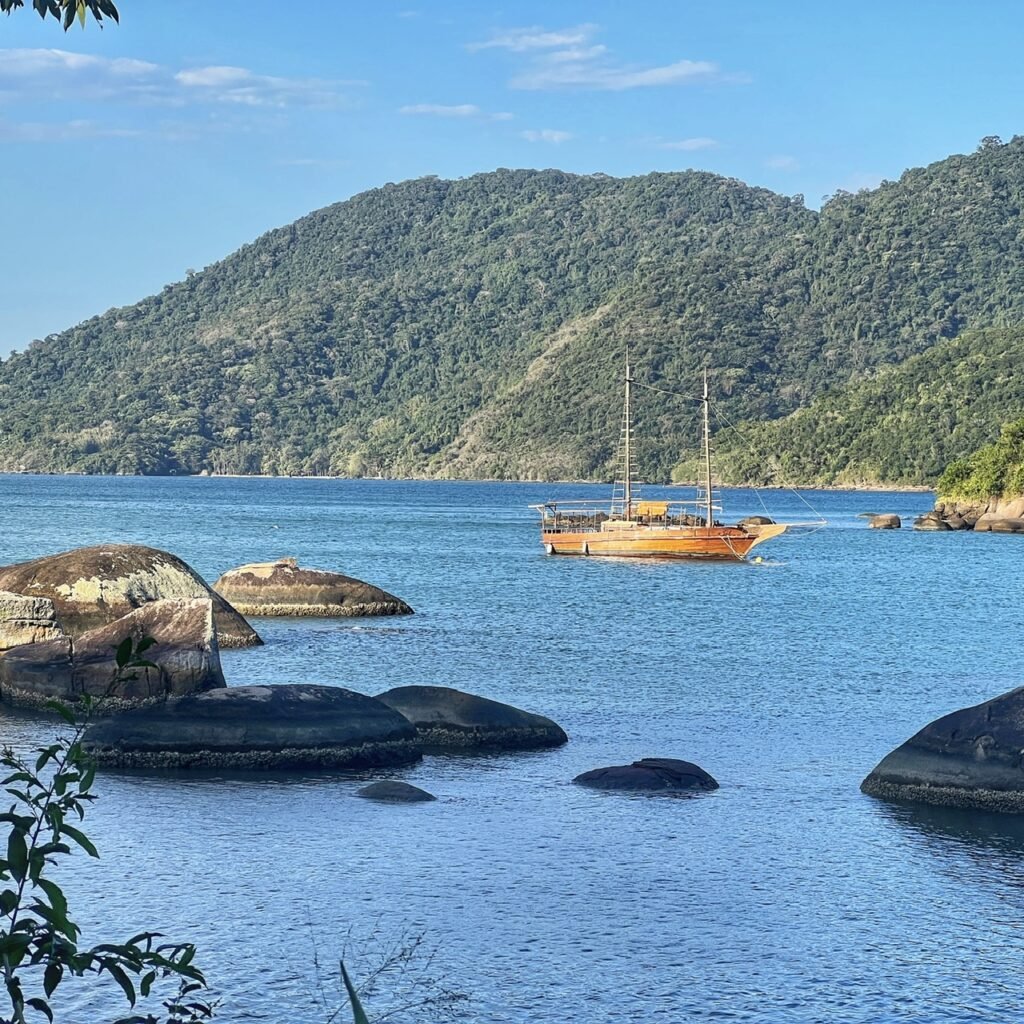
New boats and old boats alike dotted the water like toys.
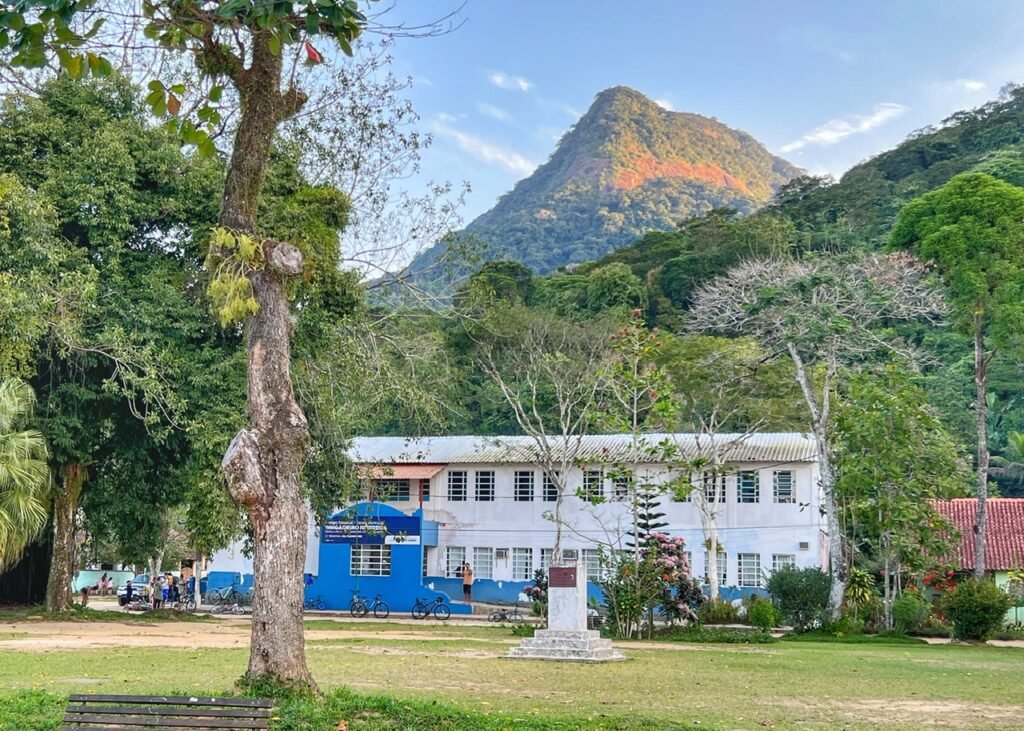
The village schoolhouse
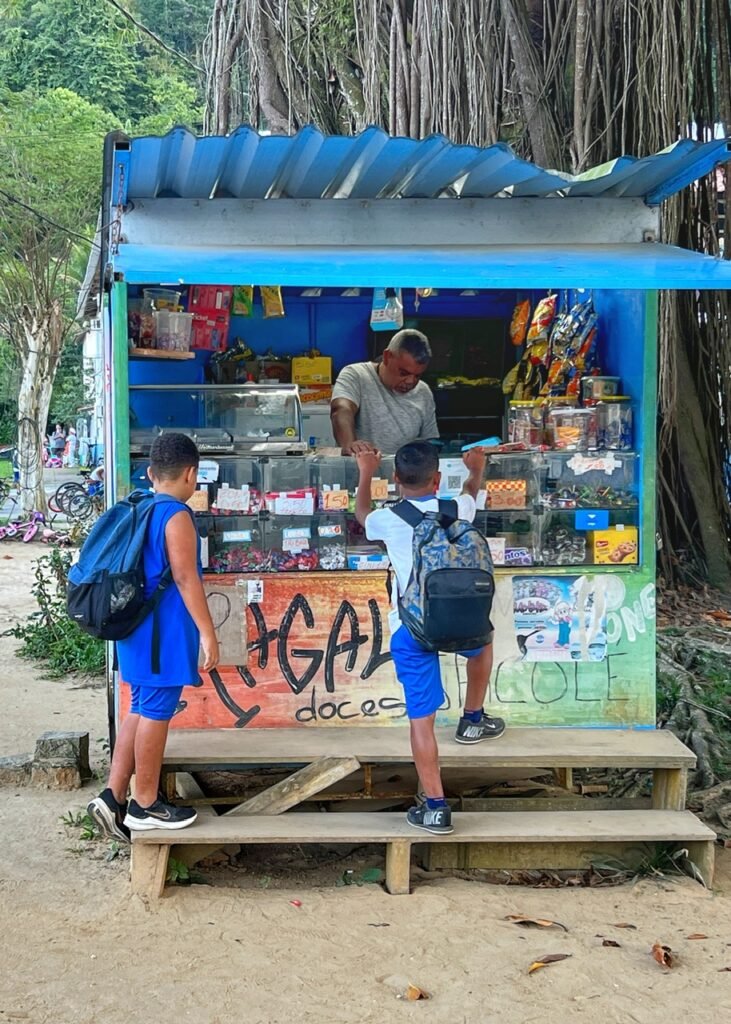
Kids using their parents money to buy sugar…like they do everywhere.
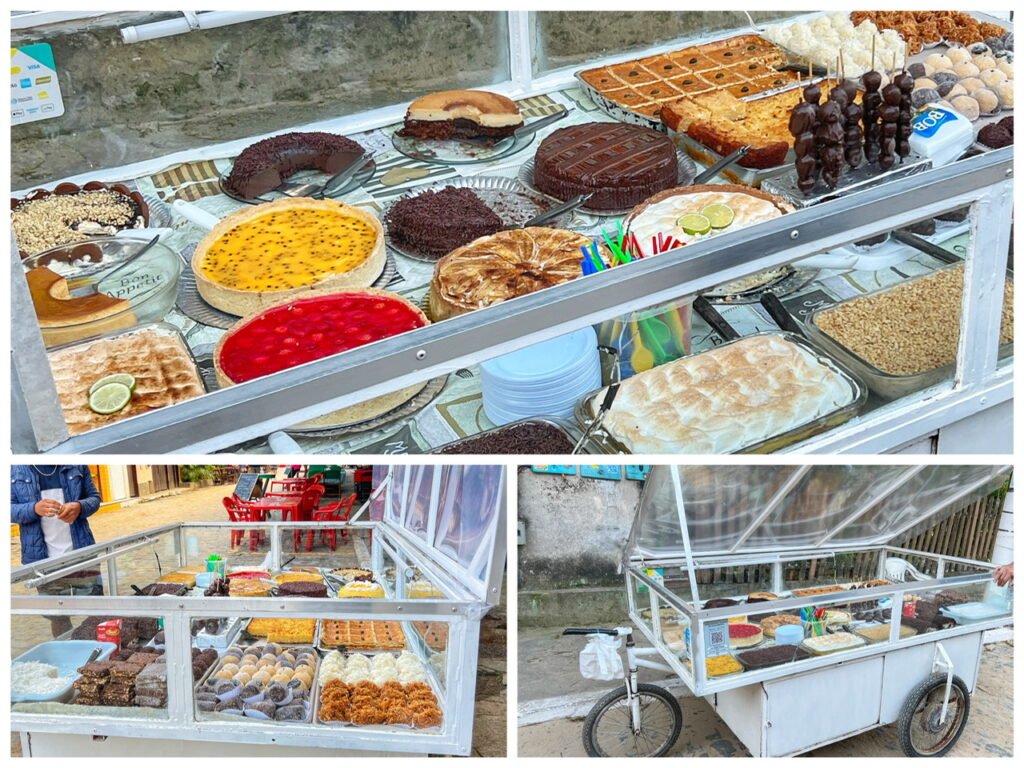
The adults, like us, prefer a different kind of food stand. At this bicycle cart contraption, he sold the most delicious looking homemade desserts, all for 13 ríales or about $2.75! We can picture his little granny in her kitchen nearby whipping them up. She’d give Betty Crocker a run for her money…they do desserts VERY well on this island, we discovered.
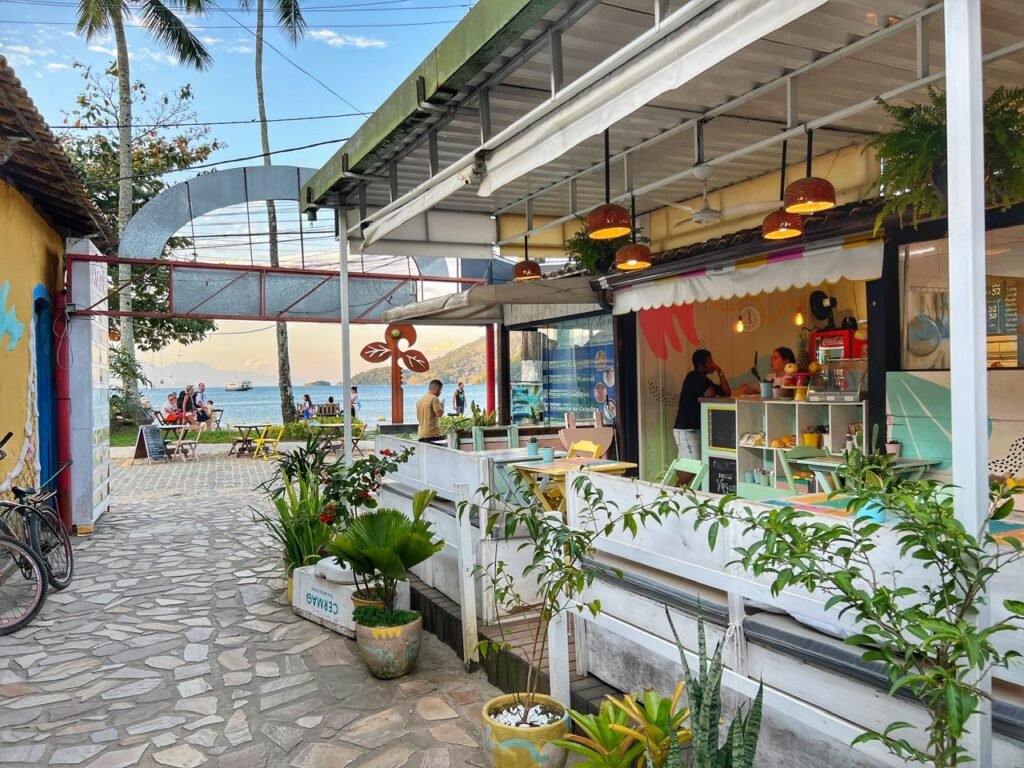

So many lovely restaurants. This one sold poke. We decided to instead head to Shima Sushi where we found surprisingly affordable and decent sushi for about $2/roll! We got all this for $10!!
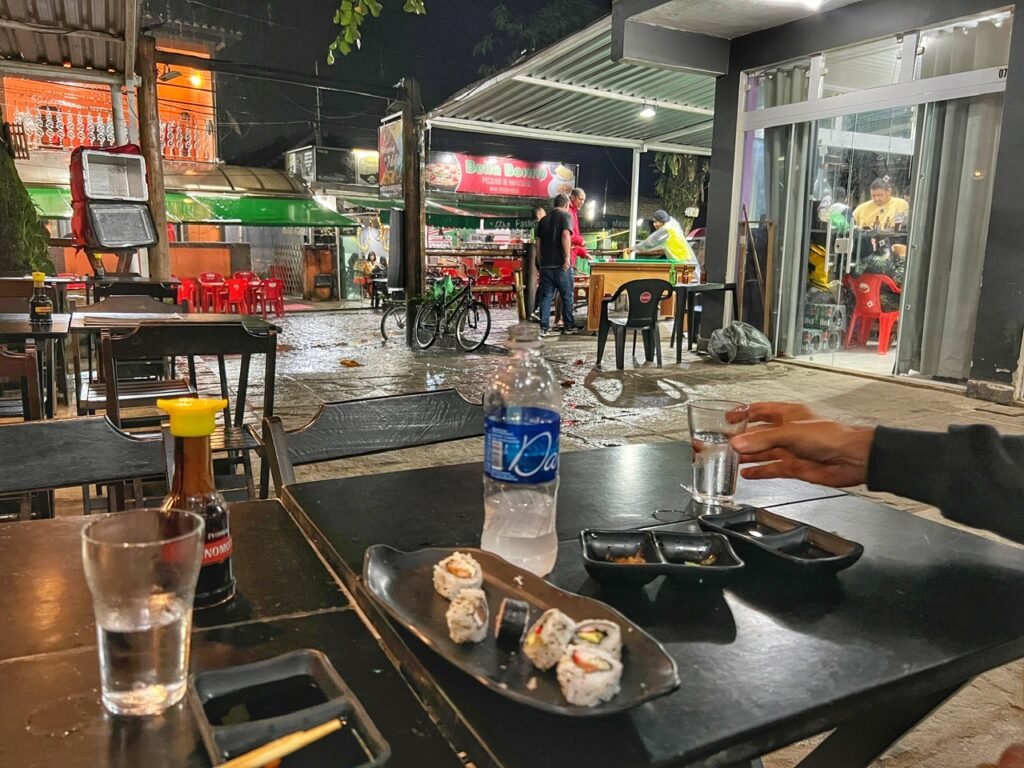
Unfortunately they didn’t open until 7, so we had to wade ourselves out in the rain. But it was very worth it!
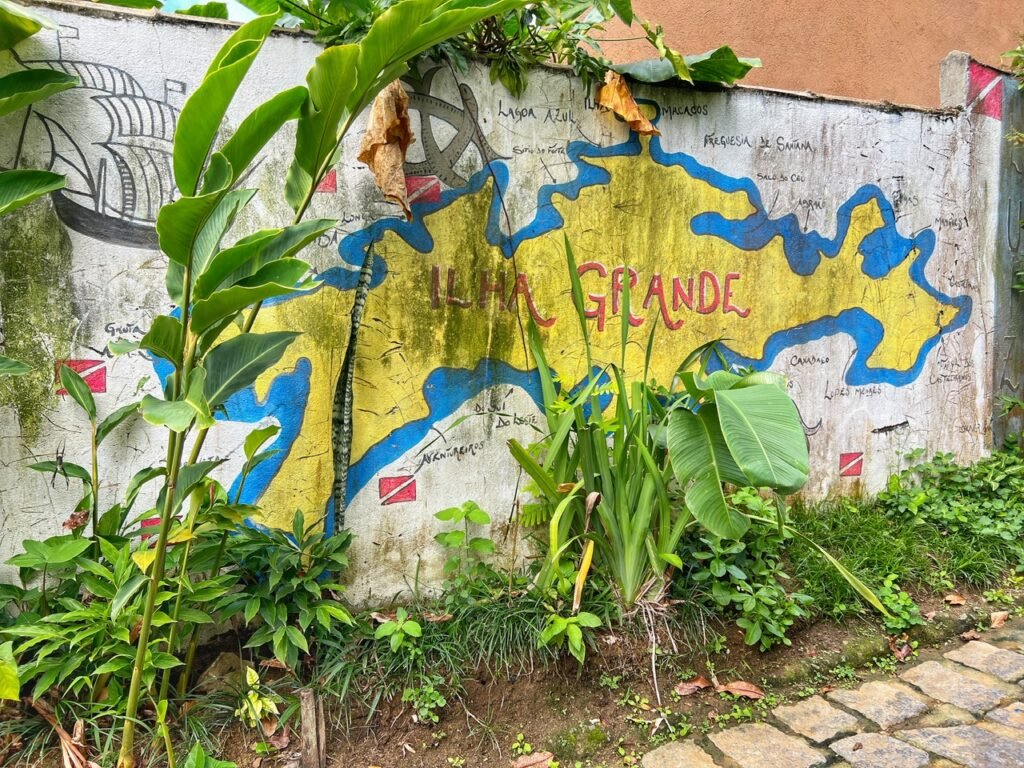
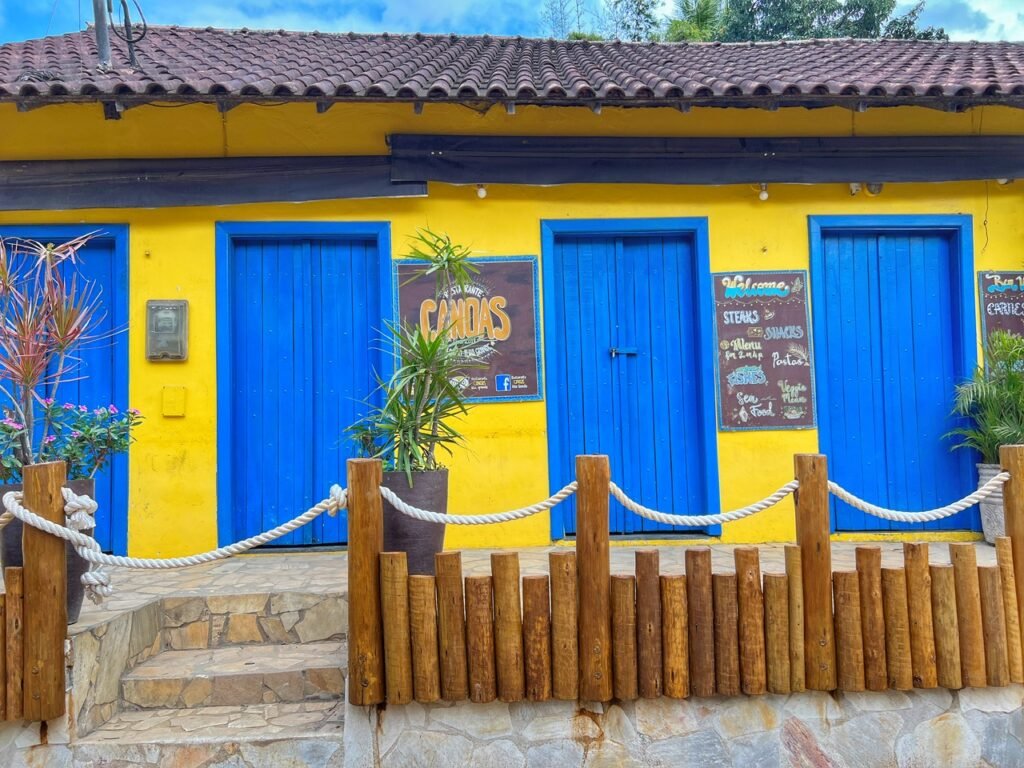
Ilha Grande is true to its size… 29 kilometers long and everywhere you go….so much color 🥰

Wondering how you do deliveries with no motorized vehicles?
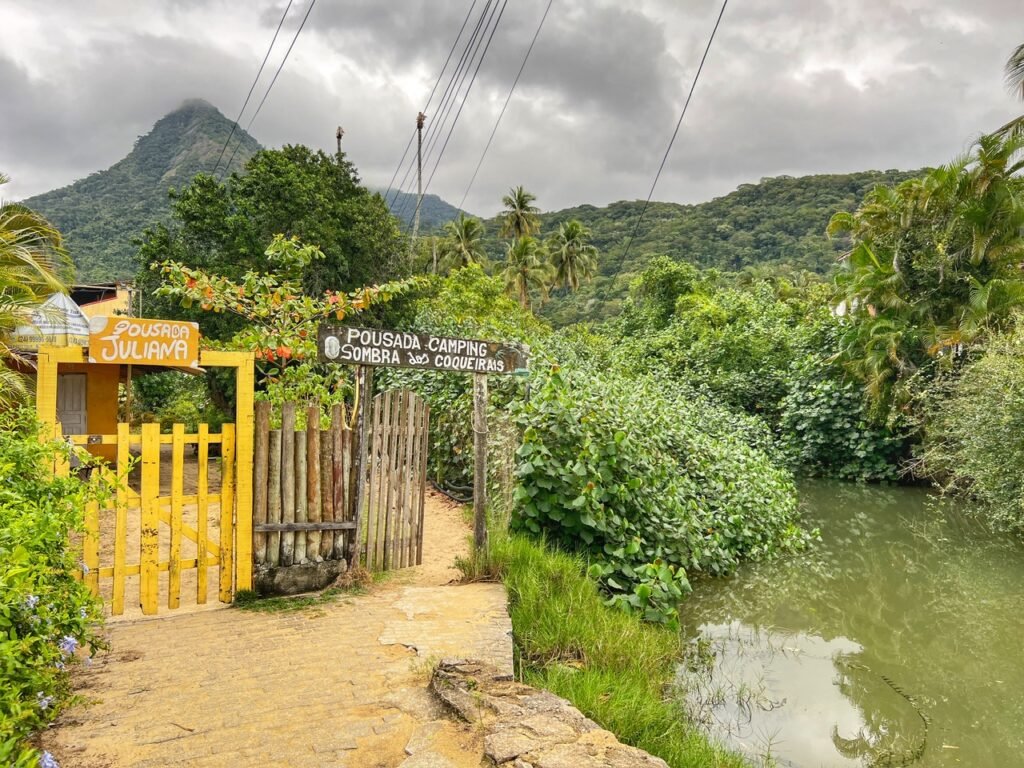

If you want even more budget friendly accommodation than our $25/night apartment, there are also lots of camping options, and welcoming pousadas, or guesthouses.
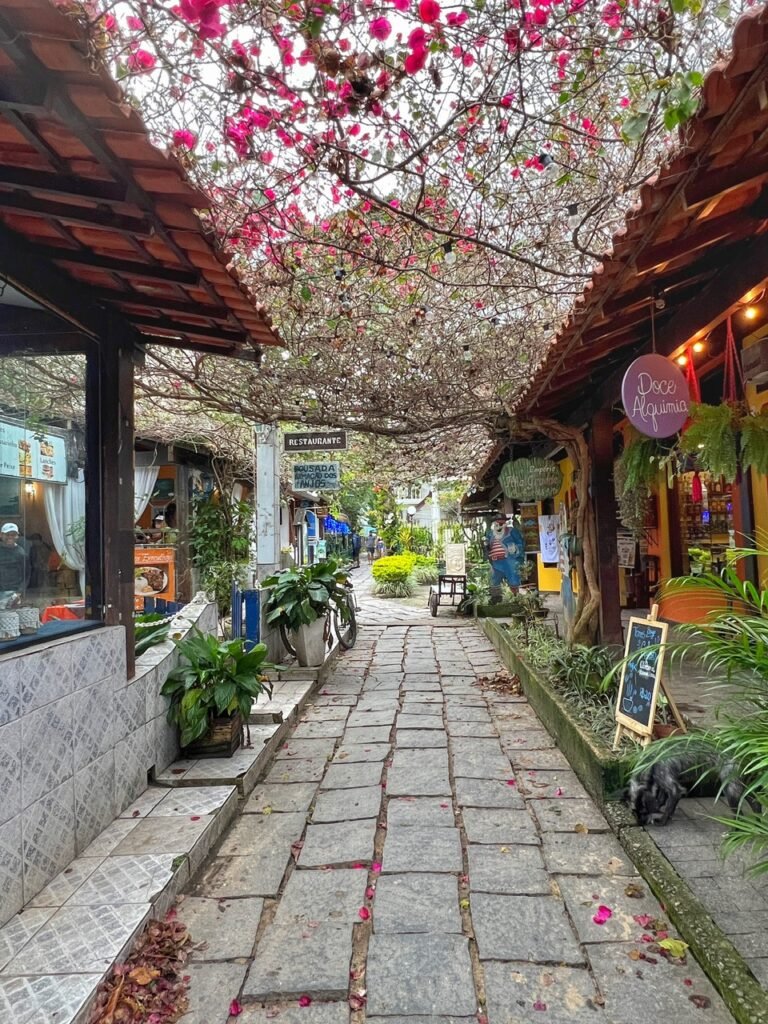
One of the main areas for a souvenir and artisan goods shopping.

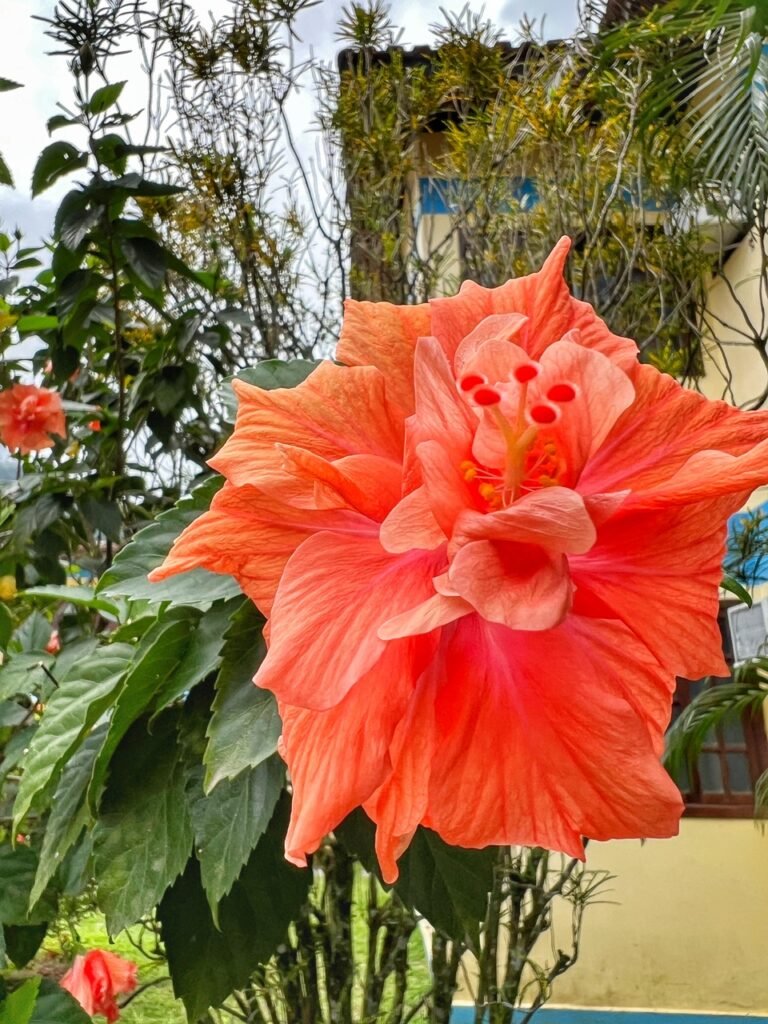
These orchids were growing all the way the side of a tree! A peach hibiscus. Never seen this variety.
More Explorations
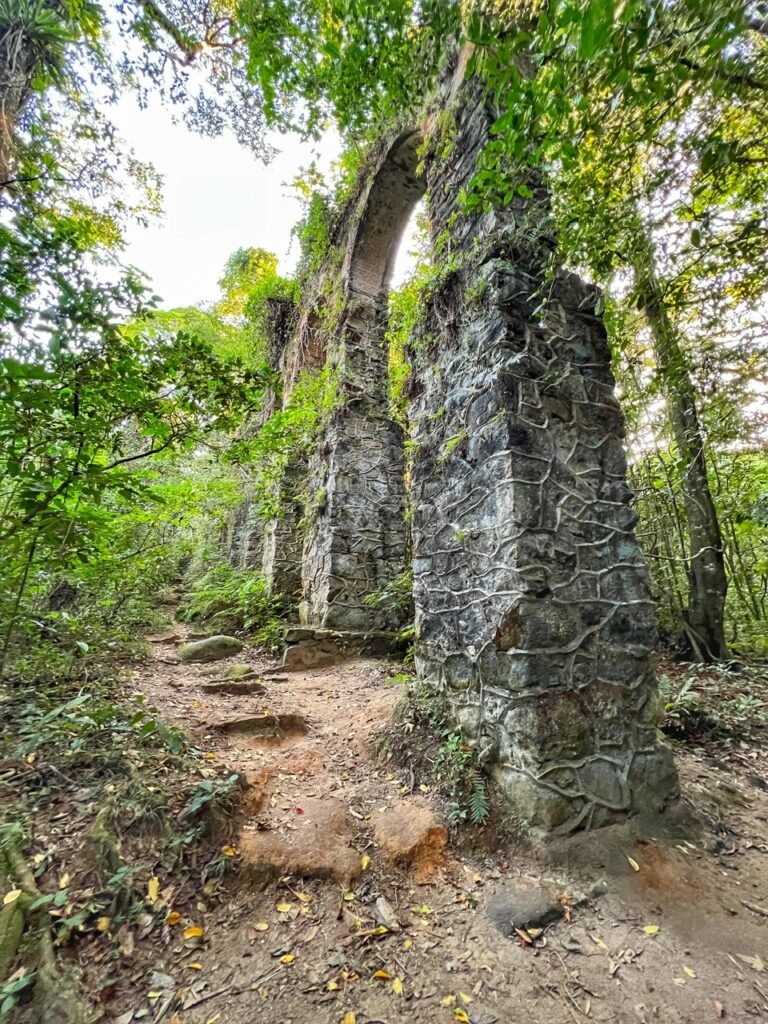
Ilha Grande wasn’t always the tourist haven that it is today. In fact, until the mid-1990s, Abraão was a sleepy fishing village which had a sordid past that for centuries did the opposite…kept people away.
Throughout history it’s been known to be a notorious pirates’ lair, a leper colony, slave trade quarters, and home of a small penitentiary for political prisoners and some of Brazil’s most violent criminals. Jolly!! This is why today, it still has only a handful of settlements, Abraão being the largest. It simply hasn’t had time to explode in growth and also, they have strict building restrictions.
All this said, the island is ripe for on-foot discovery, including waterfalls, a historic aqueduct and the ominous remains of the creepy island prison. The water supply to the island was originally provided by this aqueduct built in 1889. Built with stones and whale’s oil in 1893, the aqueduct carried water from the Abraão Stream headwater to the Lazaretto. It is 15 m high and 125 m long with dozens arches. A small dam has been built above the aqueduct, and it still supplies the Abräao Village.
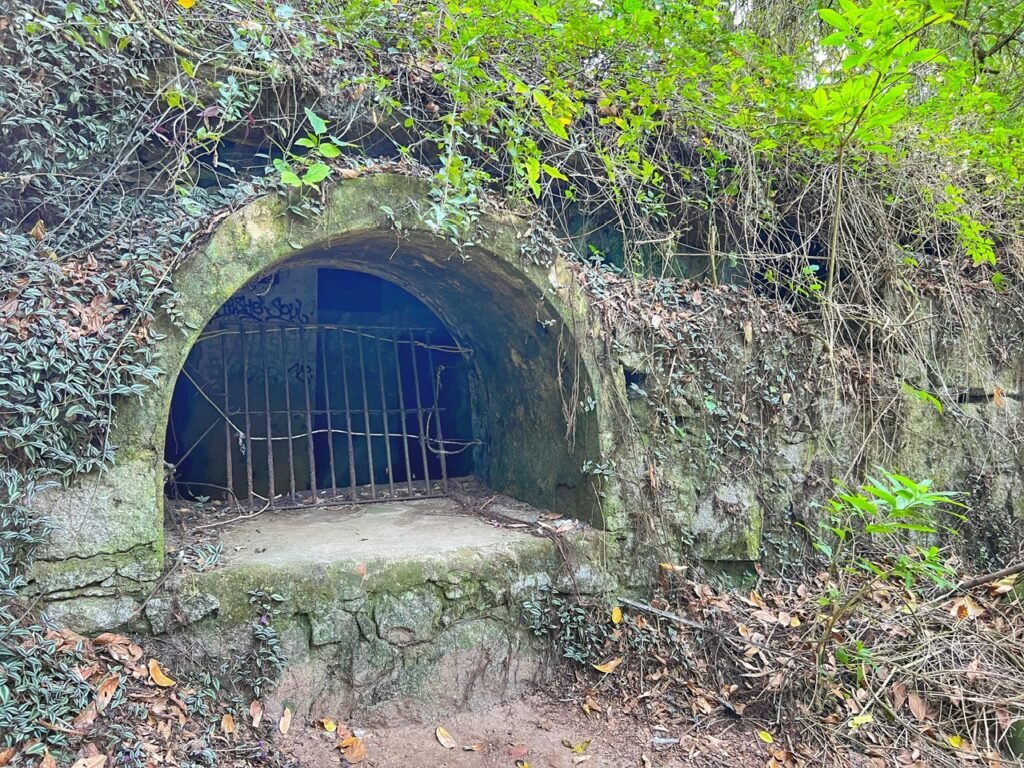
Known as Lazaretto, the remains of the penitentiary began originally as a farmhouse. In 1884, it was redesigned as a cholera quarantine stopover for European immigrants to the New World, by order of the Emperor of Brazil. A cholera epidemic threatened Brazil because of the large number of European immigrants arriving infected, and the Lazaretto was seen as a means of keeping at bay this dreaded disease and preventing its spread. It was turned into a prison seven years later. By 1940, the prisoner capacity was at over 1000. Lazaretto was closed down in 1913.


The prison was only deactivated and imploded by the government of Rio de Janeiro in 1994. Most of the prisoners were relocated but some ex-prisoners and ex-employees decided to stay on the island, running businesses. (Brazil Travel Tours.) The environment that remains is very eerie.
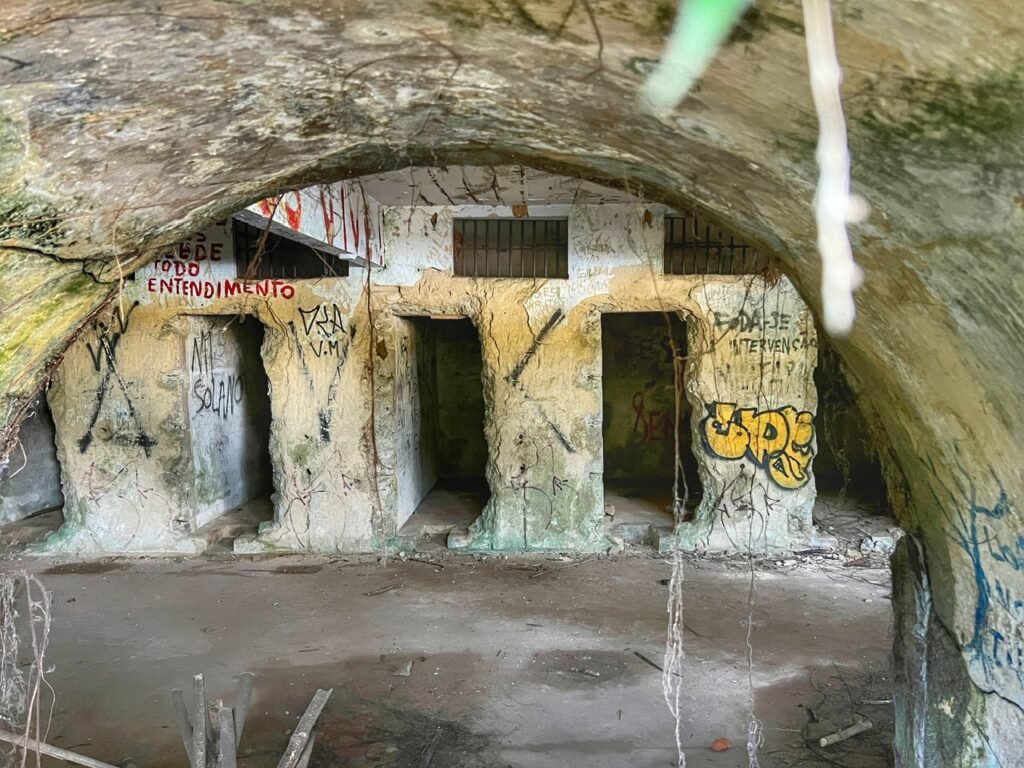
How horrific to be stuck in one of those holes!

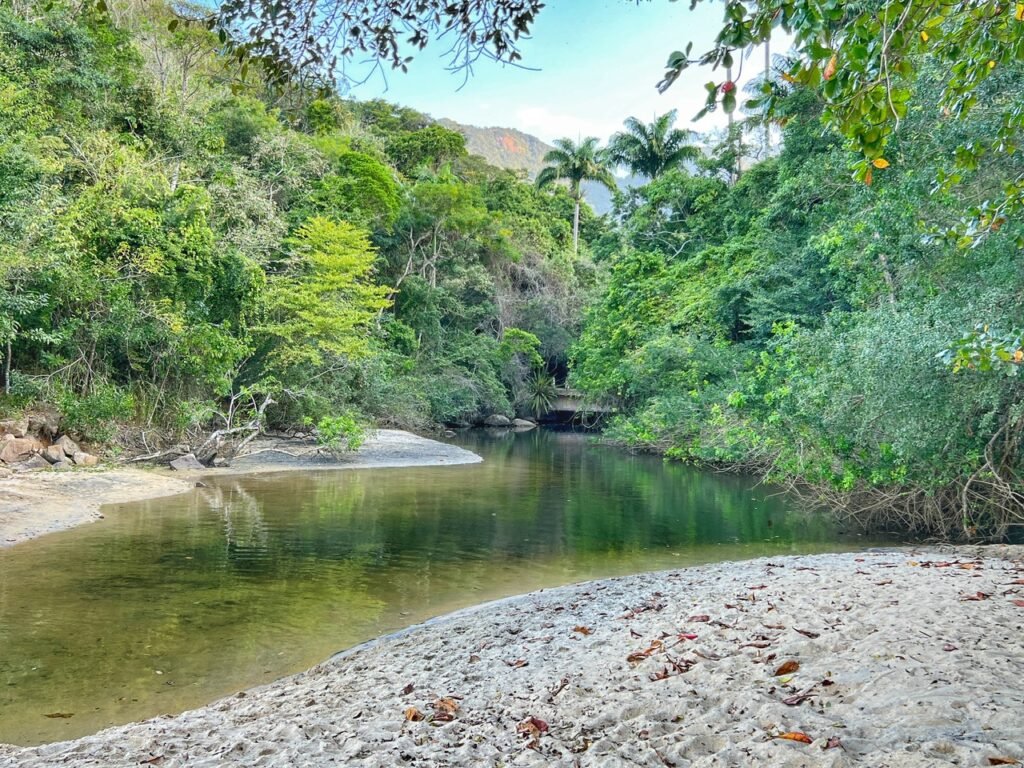
A holy shrine built into a tree next to the ruins, contrasted next to an inviting swimming hole…
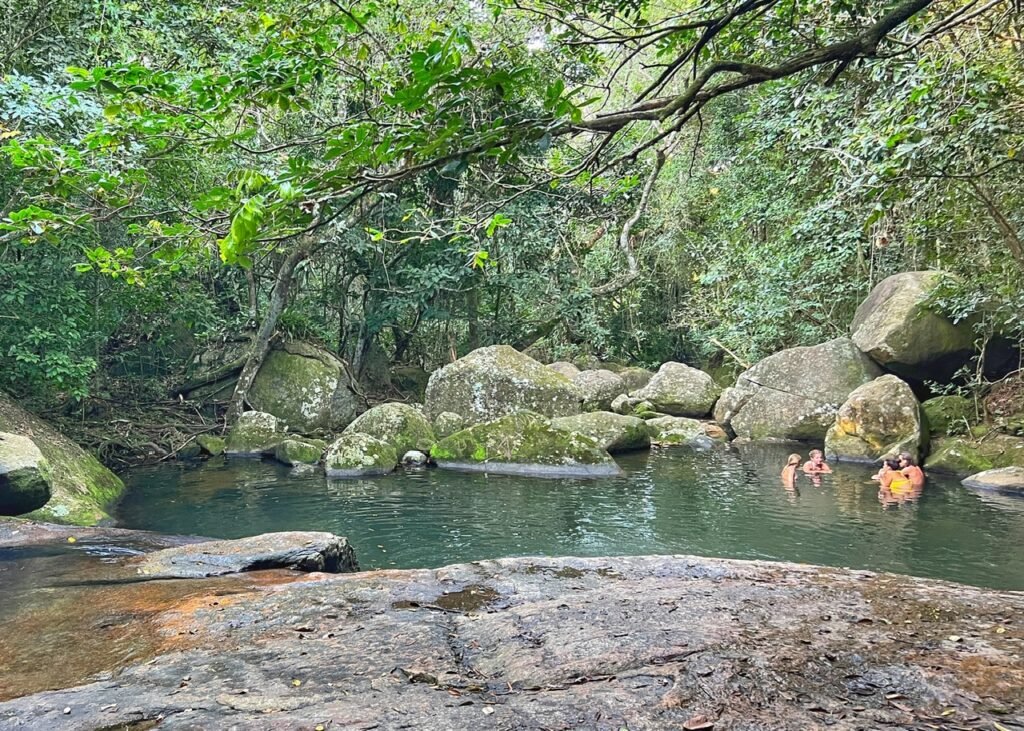
..although these are a dime a dozen on the island. They look very intriguing but it was a bit chilly to jump on in.
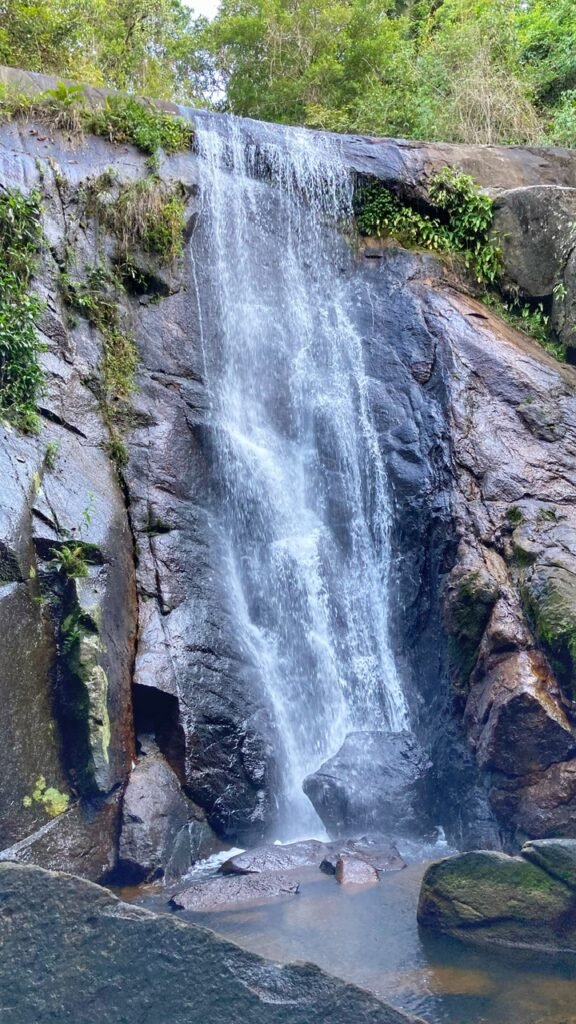
One of the many waterfalls sprinkled throughout the island. This one called Cachoeira da Feiticeira was about a 1.5 hour walk from Abraão.
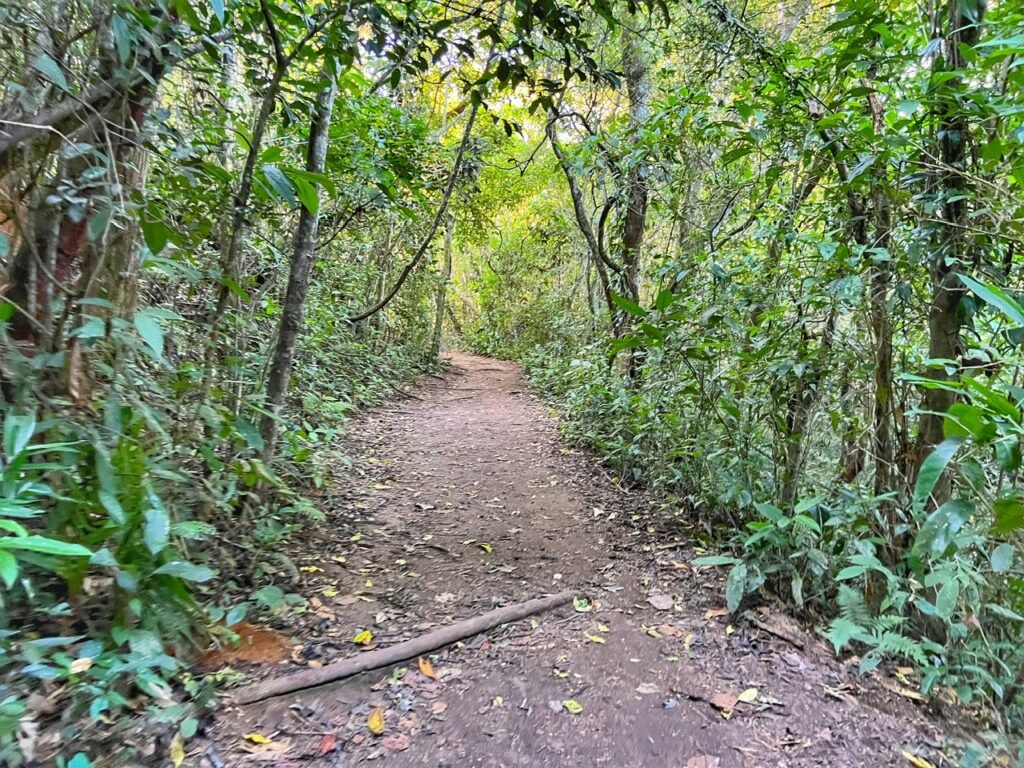
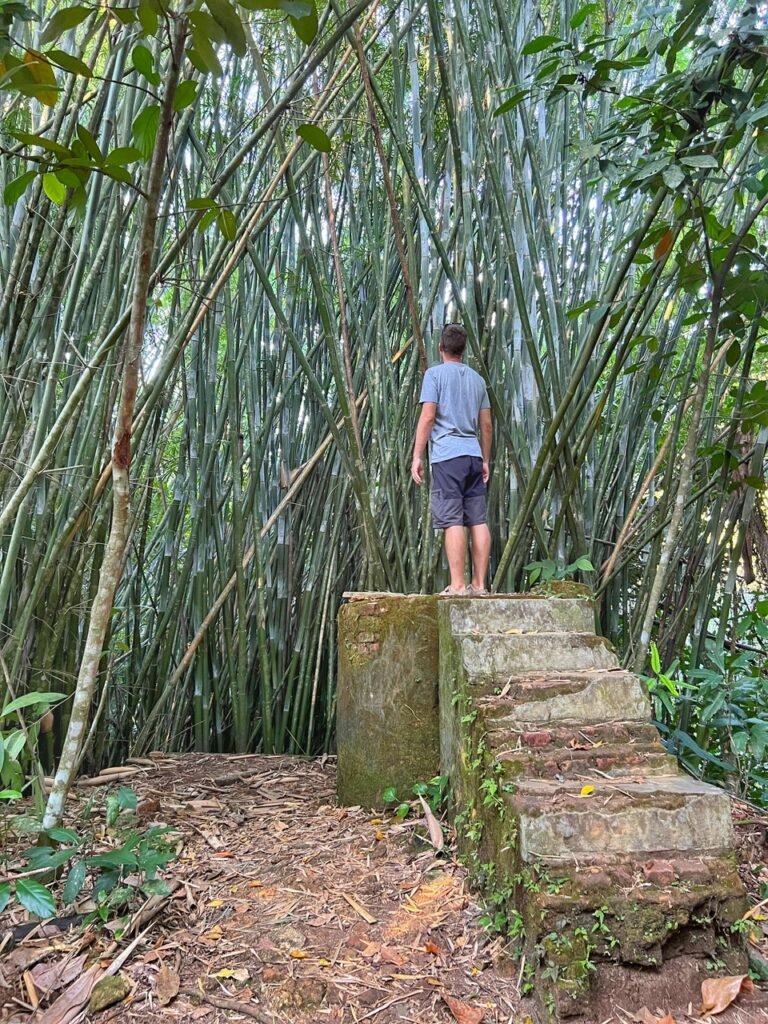
The trails are beyond tranquil and well-signed. Greg pretends he’s a panda living the dream. So much bamboo here!!



